Safety Culture and its Impact on Job Productivity Analysis
VerifiedAdded on 2023/06/07
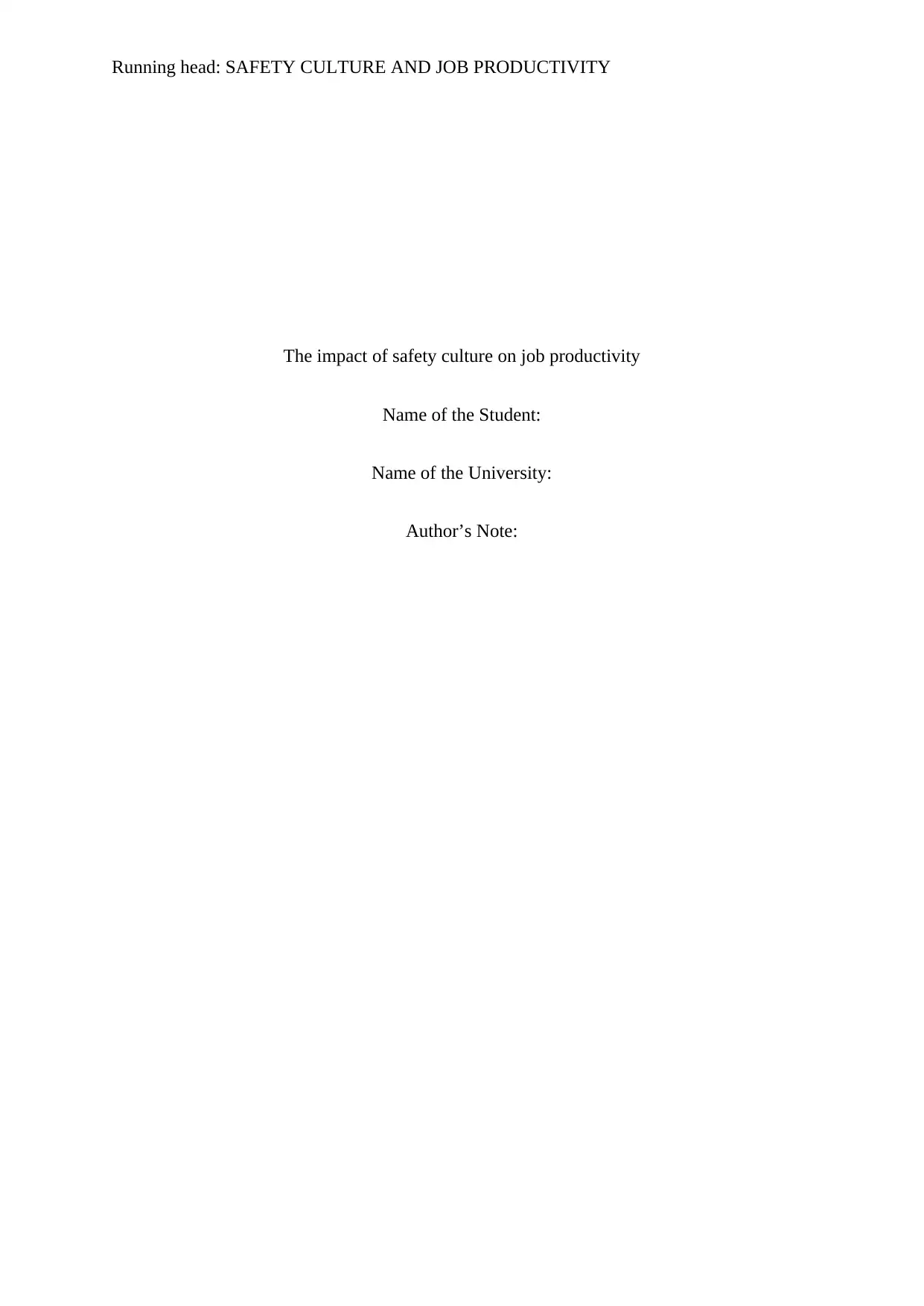
The impact of safety culture on job productivity
Name of the Student:
Name of the University:
Author’s Note:
Paraphrase This Document
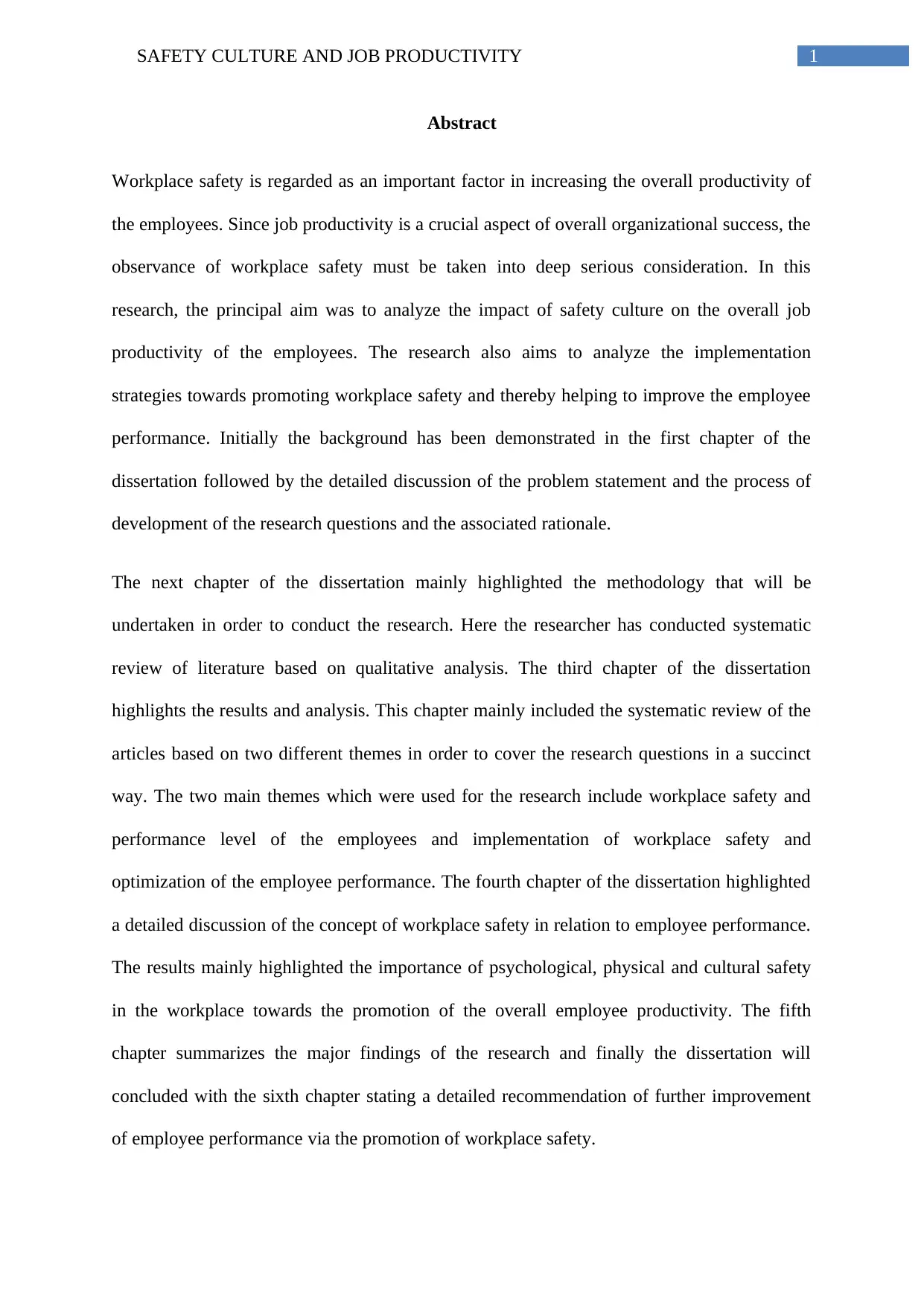
Abstract
Workplace safety is regarded as an important factor in increasing the overall productivity of
the employees. Since job productivity is a crucial aspect of overall organizational success, the
observance of workplace safety must be taken into deep serious consideration. In this
research, the principal aim was to analyze the impact of safety culture on the overall job
productivity of the employees. The research also aims to analyze the implementation
strategies towards promoting workplace safety and thereby helping to improve the employee
performance. Initially the background has been demonstrated in the first chapter of the
dissertation followed by the detailed discussion of the problem statement and the process of
development of the research questions and the associated rationale.
The next chapter of the dissertation mainly highlighted the methodology that will be
undertaken in order to conduct the research. Here the researcher has conducted systematic
review of literature based on qualitative analysis. The third chapter of the dissertation
highlights the results and analysis. This chapter mainly included the systematic review of the
articles based on two different themes in order to cover the research questions in a succinct
way. The two main themes which were used for the research include workplace safety and
performance level of the employees and implementation of workplace safety and
optimization of the employee performance. The fourth chapter of the dissertation highlighted
a detailed discussion of the concept of workplace safety in relation to employee performance.
The results mainly highlighted the importance of psychological, physical and cultural safety
in the workplace towards the promotion of the overall employee productivity. The fifth
chapter summarizes the major findings of the research and finally the dissertation will
concluded with the sixth chapter stating a detailed recommendation of further improvement
of employee performance via the promotion of workplace safety.
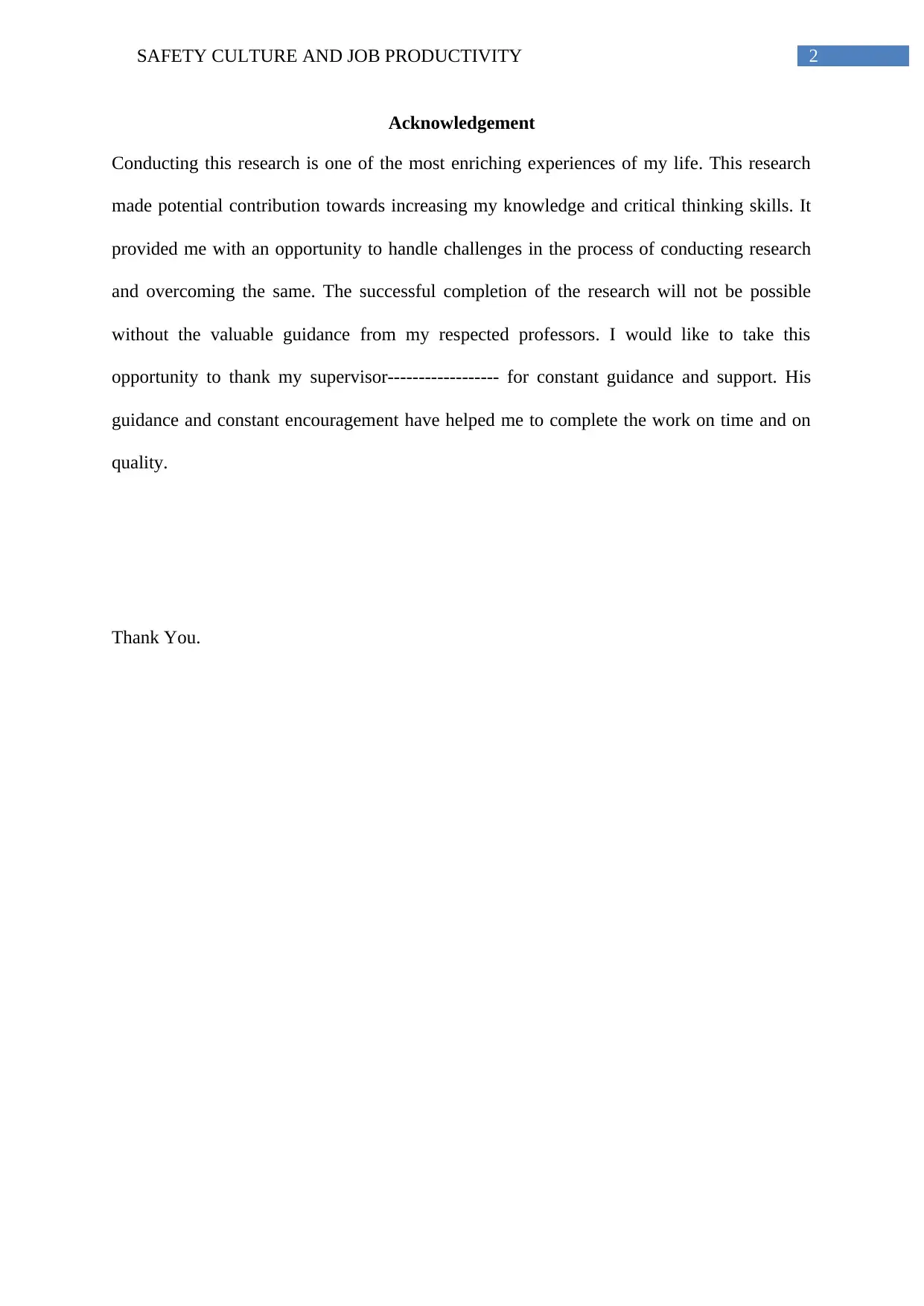
Acknowledgement
Conducting this research is one of the most enriching experiences of my life. This research
made potential contribution towards increasing my knowledge and critical thinking skills. It
provided me with an opportunity to handle challenges in the process of conducting research
and overcoming the same. The successful completion of the research will not be possible
without the valuable guidance from my respected professors. I would like to take this
opportunity to thank my supervisor------------------ for constant guidance and support. His
guidance and constant encouragement have helped me to complete the work on time and on
quality.
Thank You.
⊘ This is a preview!⊘
Do you want full access?
Subscribe today to unlock all pages.

Trusted by 1+ million students worldwide

Table of Contents
Chapter 1: INTRODUCTION....................................................................................................5
1.1 Introduction..........................................................................................................................5
1.2 Background of the Study......................................................................................................5
1.3 Research Aims and Objectives.............................................................................................6
1.3.1 Aims of the Research....................................................................................................6
1.3.2 Objectives of the Study.................................................................................................6
1.4 Research Question................................................................................................................6
1.5 Problem Statement...............................................................................................................7
1.6 Rationale for the Research Work.........................................................................................7
1.7 Research Outline..................................................................................................................8
1.8 Summary of the Chapter......................................................................................................8
Chapter 2: METHODOLOGY...................................................................................................9
2.1 Introduction..........................................................................................................................9
2.2 Method Outline....................................................................................................................9
2.3 Research onion.....................................................................................................................9
2.4 Research Philosophy..........................................................................................................10
2.5 Research Approach............................................................................................................10
2.6 Research Design.................................................................................................................11
2.7 Data Collection Process.....................................................................................................11
2.8 Research Method................................................................................................................12
Paraphrase This Document
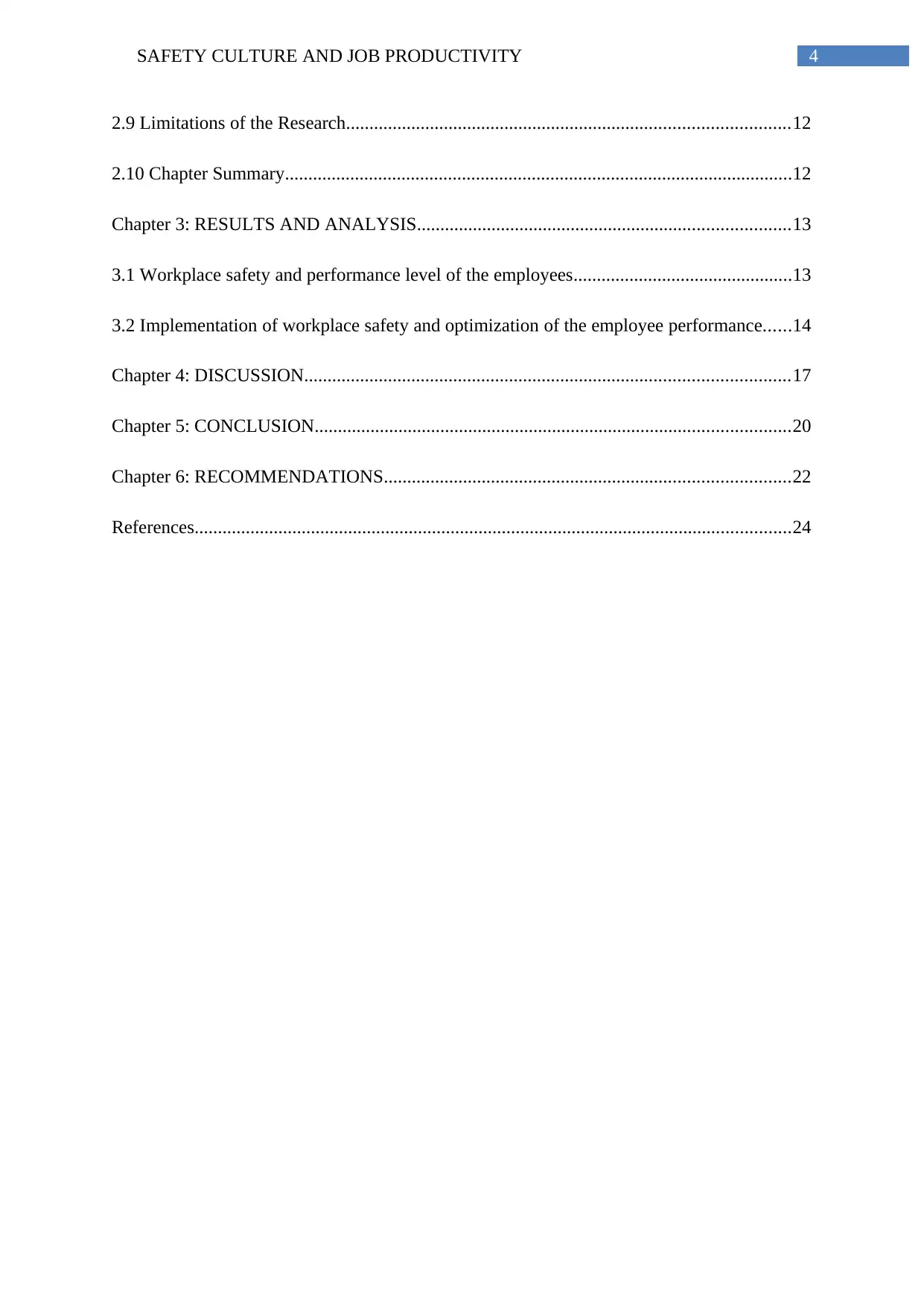
2.9 Limitations of the Research...............................................................................................12
2.10 Chapter Summary.............................................................................................................12
Chapter 3: RESULTS AND ANALYSIS................................................................................13
3.1 Workplace safety and performance level of the employees...............................................13
3.2 Implementation of workplace safety and optimization of the employee performance......14
Chapter 4: DISCUSSION........................................................................................................17
Chapter 5: CONCLUSION......................................................................................................20
Chapter 6: RECOMMENDATIONS.......................................................................................22
References................................................................................................................................24
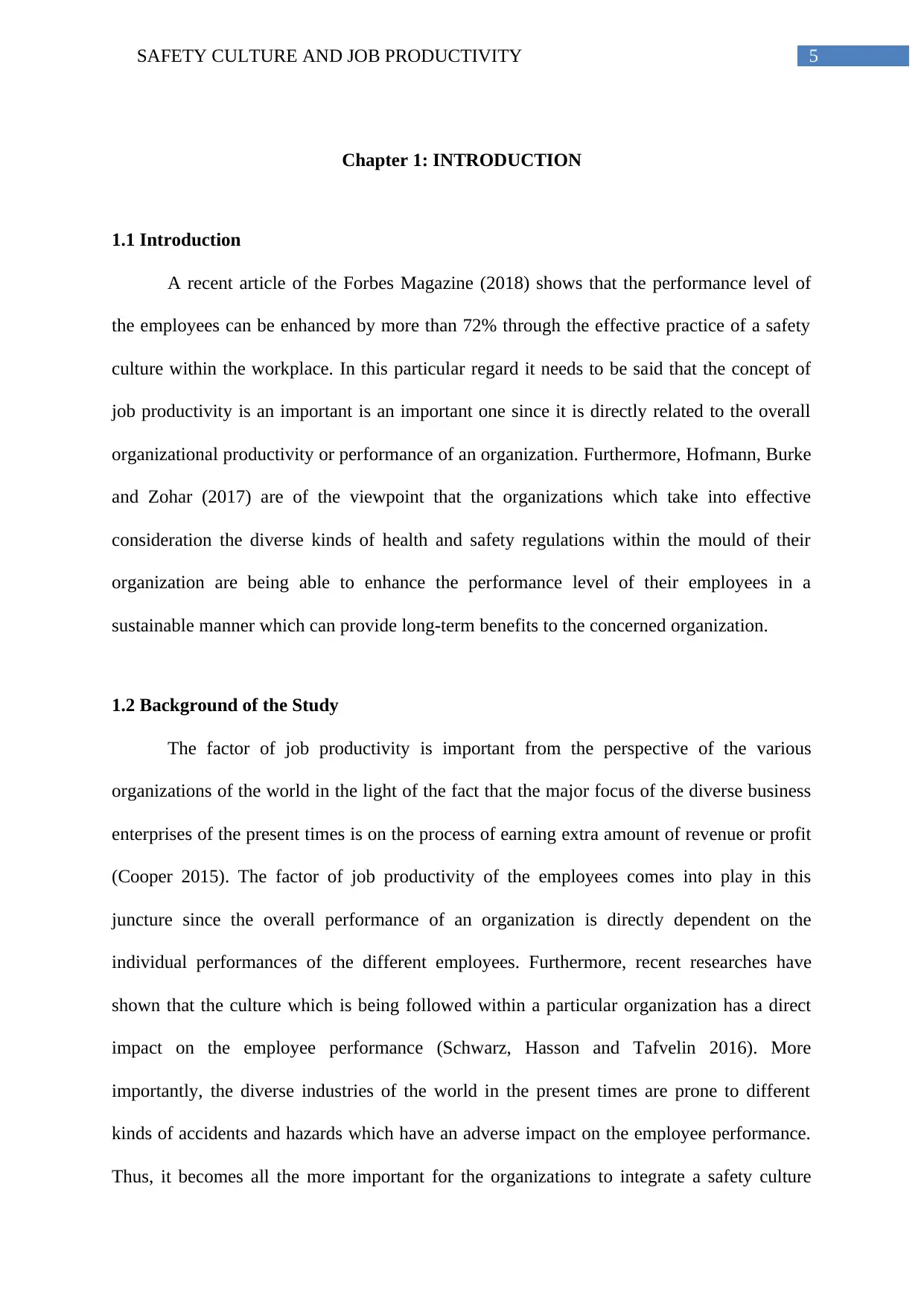
Chapter 1: INTRODUCTION
1.1 Introduction
A recent article of the Forbes Magazine (2018) shows that the performance level of
the employees can be enhanced by more than 72% through the effective practice of a safety
culture within the workplace. In this particular regard it needs to be said that the concept of
job productivity is an important is an important one since it is directly related to the overall
organizational productivity or performance of an organization. Furthermore, Hofmann, Burke
and Zohar (2017) are of the viewpoint that the organizations which take into effective
consideration the diverse kinds of health and safety regulations within the mould of their
organization are being able to enhance the performance level of their employees in a
sustainable manner which can provide long-term benefits to the concerned organization.
1.2 Background of the Study
The factor of job productivity is important from the perspective of the various
organizations of the world in the light of the fact that the major focus of the diverse business
enterprises of the present times is on the process of earning extra amount of revenue or profit
(Cooper 2015). The factor of job productivity of the employees comes into play in this
juncture since the overall performance of an organization is directly dependent on the
individual performances of the different employees. Furthermore, recent researches have
shown that the culture which is being followed within a particular organization has a direct
impact on the employee performance (Schwarz, Hasson and Tafvelin 2016). More
importantly, the diverse industries of the world in the present times are prone to different
kinds of accidents and hazards which have an adverse impact on the employee performance.
Thus, it becomes all the more important for the organizations to integrate a safety culture
⊘ This is a preview!⊘
Do you want full access?
Subscribe today to unlock all pages.

Trusted by 1+ million students worldwide
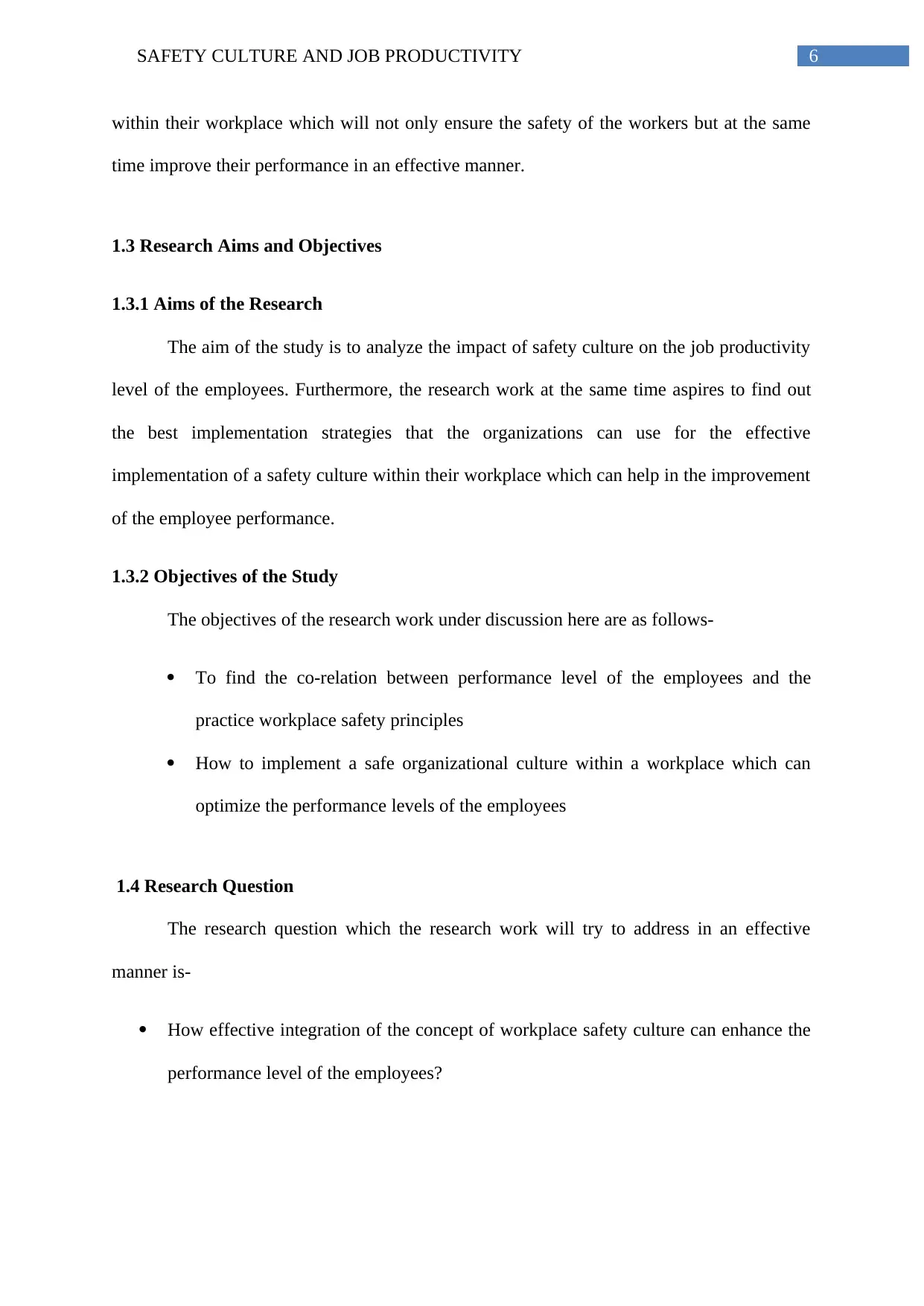
within their workplace which will not only ensure the safety of the workers but at the same
time improve their performance in an effective manner.
1.3 Research Aims and Objectives
1.3.1 Aims of the Research
The aim of the study is to analyze the impact of safety culture on the job productivity
level of the employees. Furthermore, the research work at the same time aspires to find out
the best implementation strategies that the organizations can use for the effective
implementation of a safety culture within their workplace which can help in the improvement
of the employee performance.
1.3.2 Objectives of the Study
The objectives of the research work under discussion here are as follows-
To find the co-relation between performance level of the employees and the
practice workplace safety principles
How to implement a safe organizational culture within a workplace which can
optimize the performance levels of the employees
1.4 Research Question
The research question which the research work will try to address in an effective
manner is-
How effective integration of the concept of workplace safety culture can enhance the
performance level of the employees?
Paraphrase This Document
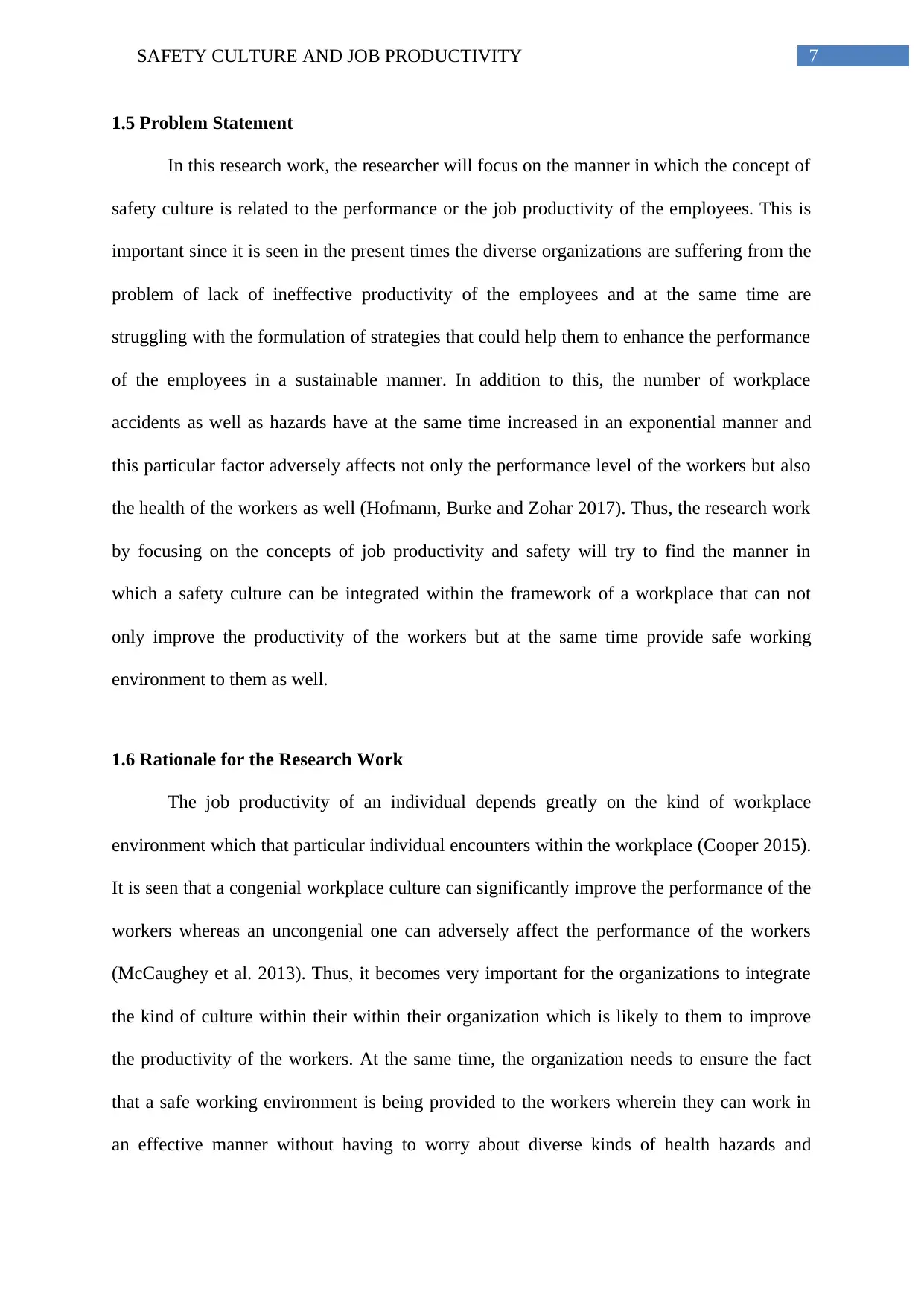
1.5 Problem Statement
In this research work, the researcher will focus on the manner in which the concept of
safety culture is related to the performance or the job productivity of the employees. This is
important since it is seen in the present times the diverse organizations are suffering from the
problem of lack of ineffective productivity of the employees and at the same time are
struggling with the formulation of strategies that could help them to enhance the performance
of the employees in a sustainable manner. In addition to this, the number of workplace
accidents as well as hazards have at the same time increased in an exponential manner and
this particular factor adversely affects not only the performance level of the workers but also
the health of the workers as well (Hofmann, Burke and Zohar 2017). Thus, the research work
by focusing on the concepts of job productivity and safety will try to find the manner in
which a safety culture can be integrated within the framework of a workplace that can not
only improve the productivity of the workers but at the same time provide safe working
environment to them as well.
1.6 Rationale for the Research Work
The job productivity of an individual depends greatly on the kind of workplace
environment which that particular individual encounters within the workplace (Cooper 2015).
It is seen that a congenial workplace culture can significantly improve the performance of the
workers whereas an uncongenial one can adversely affect the performance of the workers
(McCaughey et al. 2013). Thus, it becomes very important for the organizations to integrate
the kind of culture within their within their organization which is likely to them to improve
the productivity of the workers. At the same time, the organization needs to ensure the fact
that a safe working environment is being provided to the workers wherein they can work in
an effective manner without having to worry about diverse kinds of health hazards and
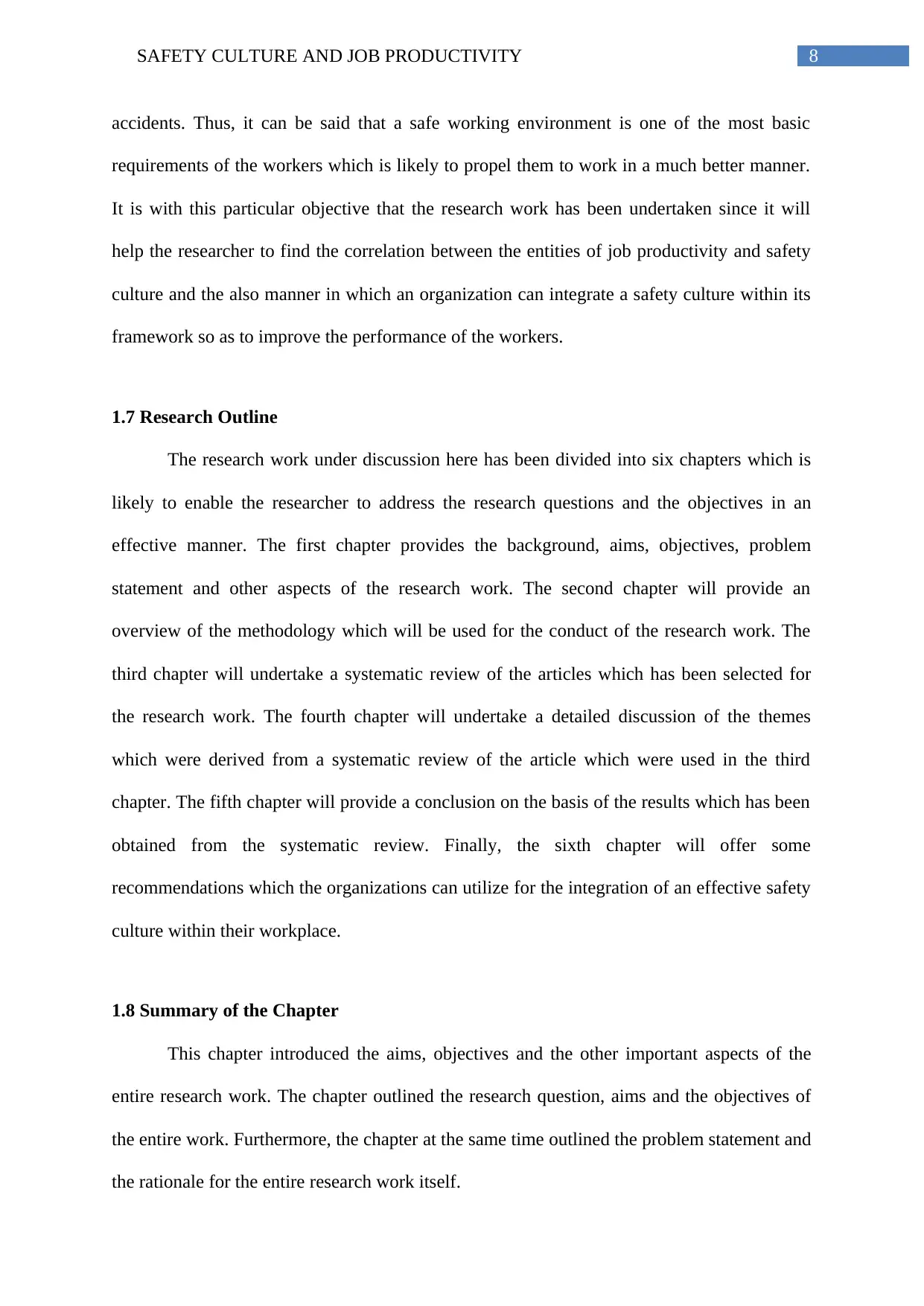
accidents. Thus, it can be said that a safe working environment is one of the most basic
requirements of the workers which is likely to propel them to work in a much better manner.
It is with this particular objective that the research work has been undertaken since it will
help the researcher to find the correlation between the entities of job productivity and safety
culture and the also manner in which an organization can integrate a safety culture within its
framework so as to improve the performance of the workers.
1.7 Research Outline
The research work under discussion here has been divided into six chapters which is
likely to enable the researcher to address the research questions and the objectives in an
effective manner. The first chapter provides the background, aims, objectives, problem
statement and other aspects of the research work. The second chapter will provide an
overview of the methodology which will be used for the conduct of the research work. The
third chapter will undertake a systematic review of the articles which has been selected for
the research work. The fourth chapter will undertake a detailed discussion of the themes
which were derived from a systematic review of the article which were used in the third
chapter. The fifth chapter will provide a conclusion on the basis of the results which has been
obtained from the systematic review. Finally, the sixth chapter will offer some
recommendations which the organizations can utilize for the integration of an effective safety
culture within their workplace.
1.8 Summary of the Chapter
This chapter introduced the aims, objectives and the other important aspects of the
entire research work. The chapter outlined the research question, aims and the objectives of
the entire work. Furthermore, the chapter at the same time outlined the problem statement and
the rationale for the entire research work itself.
⊘ This is a preview!⊘
Do you want full access?
Subscribe today to unlock all pages.

Trusted by 1+ million students worldwide
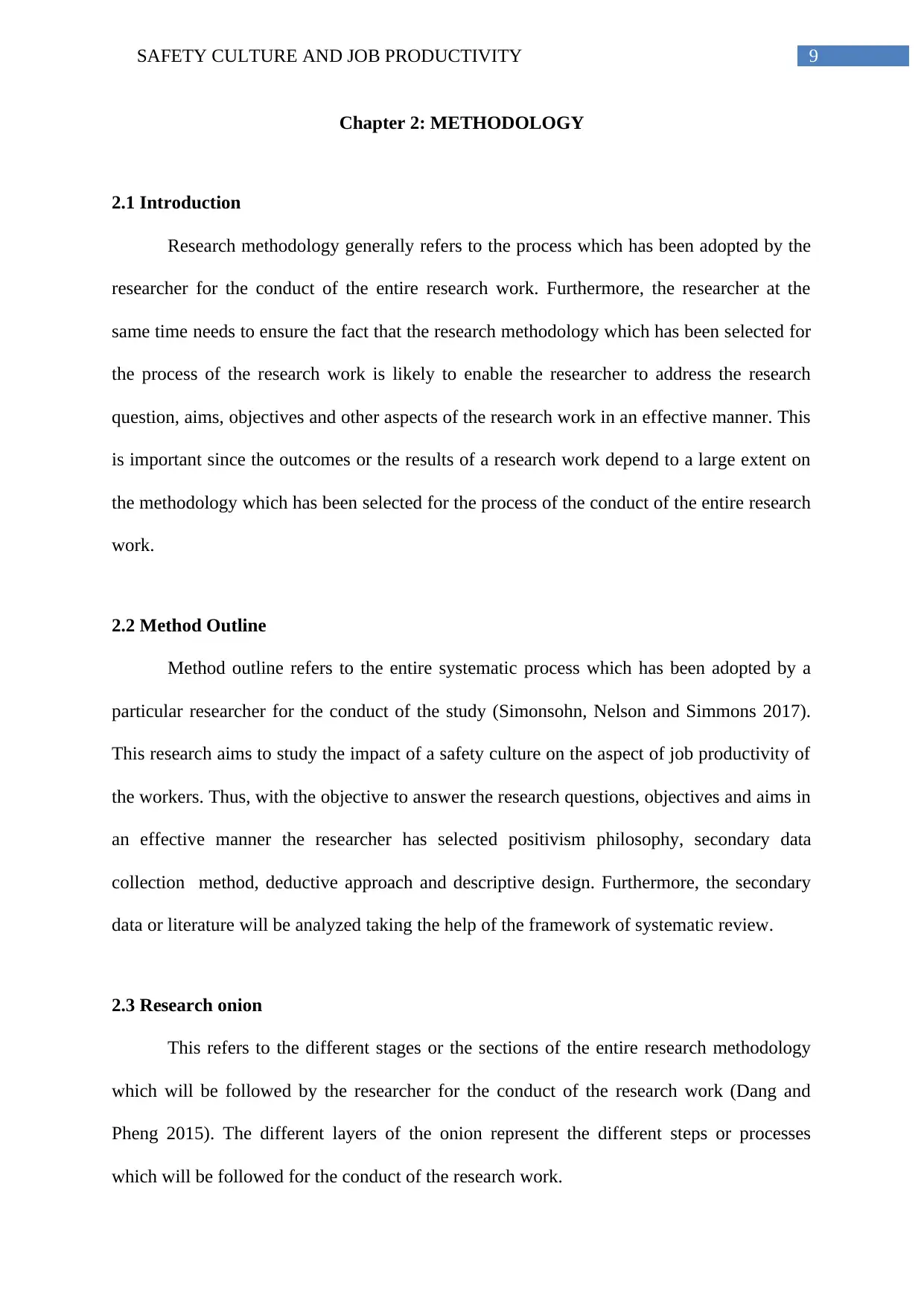
Chapter 2: METHODOLOGY
2.1 Introduction
Research methodology generally refers to the process which has been adopted by the
researcher for the conduct of the entire research work. Furthermore, the researcher at the
same time needs to ensure the fact that the research methodology which has been selected for
the process of the research work is likely to enable the researcher to address the research
question, aims, objectives and other aspects of the research work in an effective manner. This
is important since the outcomes or the results of a research work depend to a large extent on
the methodology which has been selected for the process of the conduct of the entire research
work.
2.2 Method Outline
Method outline refers to the entire systematic process which has been adopted by a
particular researcher for the conduct of the study (Simonsohn, Nelson and Simmons 2017).
This research aims to study the impact of a safety culture on the aspect of job productivity of
the workers. Thus, with the objective to answer the research questions, objectives and aims in
an effective manner the researcher has selected positivism philosophy, secondary data
collection method, deductive approach and descriptive design. Furthermore, the secondary
data or literature will be analyzed taking the help of the framework of systematic review.
2.3 Research onion
This refers to the different stages or the sections of the entire research methodology
which will be followed by the researcher for the conduct of the research work (Dang and
Pheng 2015). The different layers of the onion represent the different steps or processes
which will be followed for the conduct of the research work.
Paraphrase This Document
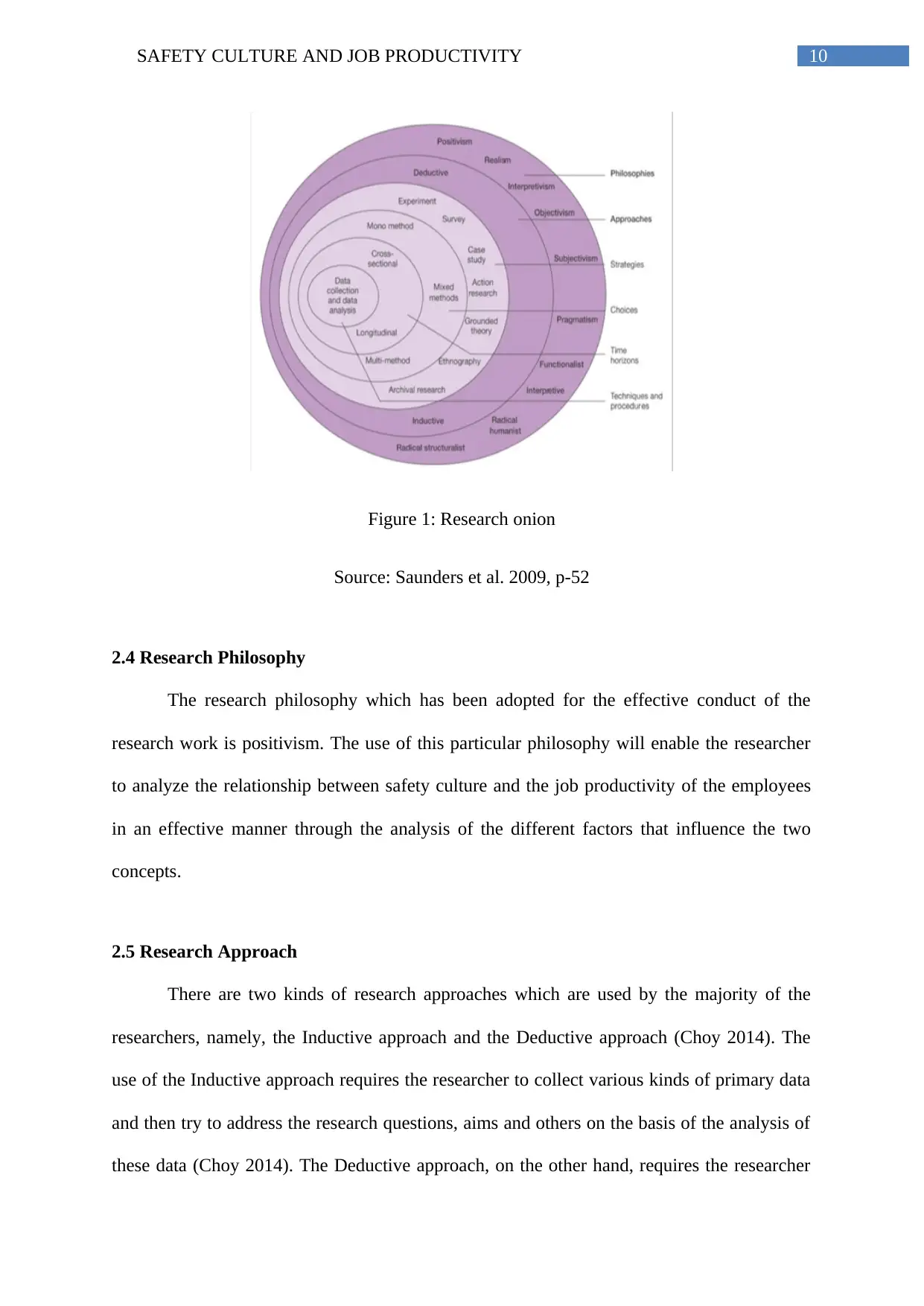
Figure 1: Research onion
Source: Saunders et al. 2009, p-52
2.4 Research Philosophy
The research philosophy which has been adopted for the effective conduct of the
research work is positivism. The use of this particular philosophy will enable the researcher
to analyze the relationship between safety culture and the job productivity of the employees
in an effective manner through the analysis of the different factors that influence the two
concepts.
2.5 Research Approach
There are two kinds of research approaches which are used by the majority of the
researchers, namely, the Inductive approach and the Deductive approach (Choy 2014). The
use of the Inductive approach requires the researcher to collect various kinds of primary data
and then try to address the research questions, aims and others on the basis of the analysis of
these data (Choy 2014). The Deductive approach, on the other hand, requires the researcher

to address the research questions, aims and others on the basis of the theories, frameworks
and others proposed by the past scholars and researchers (Choy 2014). The chosen approach
for the process of this research work is Deductive approach.
2.6 Research Design
There are three kinds or types of research designs which are commonly being used by
the different researchers, namely, descriptive, explanatory and finally exploratory (Silverman
2016). The exploratory design is concerned with the analysis of the past literature related to
the problem statement which has been identified (Silverman 2016). The explanatory design,
on the other hand, is concerned with finding the reasons or possible justifications for the
problem statement (Taylor, Bogdan and DeVault 2015). Finally, the descriptive design is
concerned with process of answering the objectives and the aims of the research in the light
of the results obtained from the data collection (Glesne 2015). The researcher for this
research work has selected descriptive design.
2.7 Data Collection Process
The researcher took the help of the secondary data collection process for the
collection of the necessary data. Initially 30 peer reviewed articles were selected on the basis
of the titles of those articles however after reading the abstract the researcher found out that
15 of them were not important for the research work. Furthermore, the research after reading
the entire set of 15 articles finally selected 8 papers and conducted systematic review to
derive the necessary data which were needed for the completion of the study.
⊘ This is a preview!⊘
Do you want full access?
Subscribe today to unlock all pages.

Trusted by 1+ million students worldwide

2.8 Research Method
There are two kinds of research methods which are being commonly used by the
majority of the researchers, namely, qualitative and quantitative (Flick 2015). For the conduct
of this research work the researcher took the help of qualitative research method.
2.9 Limitations of the Research
The primary limitation of the study can be said to be the fact that the researcher was
able to review only eight peer reviewed articles for the conduct of the systematic review
because of the lack of time. Furthermore, the researcher at the same time had to depend only
on the articles provided by the journal database Google Scholar and the educational
institution library since the other databases are paid ones.
2.10 Chapter Summary
This chapter discussed about the research methodology which has been used by the
researcher for the effective conduct of the study. The research methodology and its diverse
components were selected by the researcher keeping in view the objectives, aims, research
question and the other aspects of the study. Furthermore, effective selection of the
methodology enabled the researcher to derive the necessary data which were needed to
answer the research question in an effective manner.
Paraphrase This Document

Chapter 3: RESULTS AND ANALYSIS
3.1 Workplace safety and performance level of the employees
Safety climate is a specific form of organisational workplace safety. This safety
climate helps to influence the behaviour of the employees at various organisational levels and
refers to the degree to which employees true priority of the organisation is directed towards
the safety f their performance (Tappura et al. 2015). In order to determine the impact of the
workplace safety overall the overall performance of the employee Al-Refaie (2013)
conducted a research over the Jordon companies. Al-Refaie (2013) undertook 324 surveys
over the Jordanian companies and used structural equation modelling for data analysis. The
results of the data-analysis revealed that improvement of the workplace safety help in the
improving of the overall productivity of the employees. The workplace safety is specifically
affects the management commitment, harmony, interrelationships and employee
empowerment which influence safety performance. Increase in the parameter of the safety
performance helps to improve the overall productivity of the employee. Al-Refaie (2013)
stated that increase in the workplace safety promotes a blameless culture, which enhances the
self-efficacy and continuous improvement. These two factors in turn help to promote higher
employee performance. While discussing the effect of workplace safety on the employee
performance Singh, Winkel and Selvarajan (2013) mainly stressed over the psychological
safety of the employees. Their research is mainly based on the hypothesis that psychological
safety mediates proper relationship between the diversity climate and the overall employee
performance. They also proposed that the race moderates the stages of mediation and thereby
helping to impact the relationships between the psychological safety and diversity climate.
The analysis of the results revealed that increase in the level of psychological safety helps to
increase the overall performance of the employee performance. Guchait, Paşamehmetoğlu
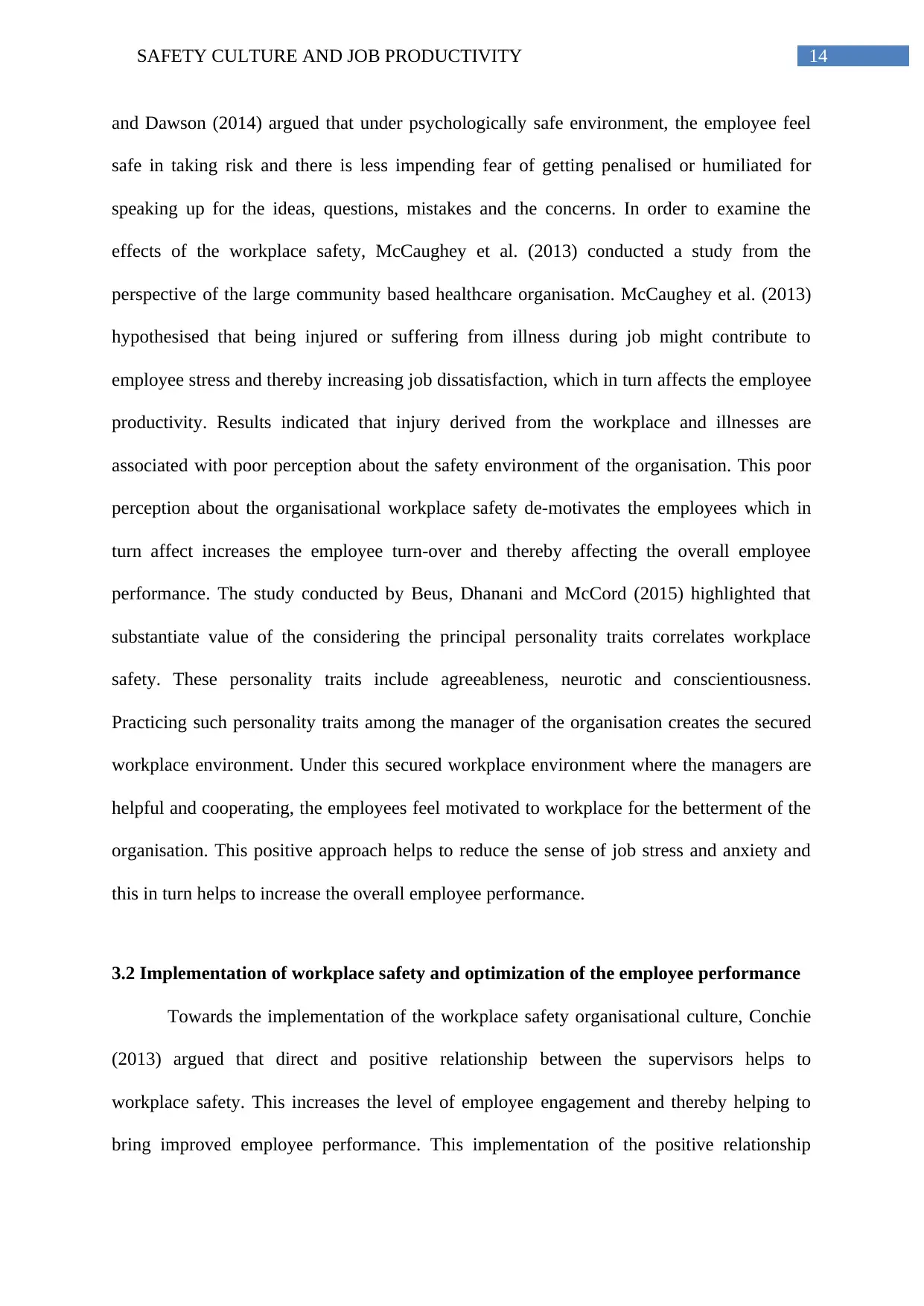
and Dawson (2014) argued that under psychologically safe environment, the employee feel
safe in taking risk and there is less impending fear of getting penalised or humiliated for
speaking up for the ideas, questions, mistakes and the concerns. In order to examine the
effects of the workplace safety, McCaughey et al. (2013) conducted a study from the
perspective of the large community based healthcare organisation. McCaughey et al. (2013)
hypothesised that being injured or suffering from illness during job might contribute to
employee stress and thereby increasing job dissatisfaction, which in turn affects the employee
productivity. Results indicated that injury derived from the workplace and illnesses are
associated with poor perception about the safety environment of the organisation. This poor
perception about the organisational workplace safety de-motivates the employees which in
turn affect increases the employee turn-over and thereby affecting the overall employee
performance. The study conducted by Beus, Dhanani and McCord (2015) highlighted that
substantiate value of the considering the principal personality traits correlates workplace
safety. These personality traits include agreeableness, neurotic and conscientiousness.
Practicing such personality traits among the manager of the organisation creates the secured
workplace environment. Under this secured workplace environment where the managers are
helpful and cooperating, the employees feel motivated to workplace for the betterment of the
organisation. This positive approach helps to reduce the sense of job stress and anxiety and
this in turn helps to increase the overall employee performance.
3.2 Implementation of workplace safety and optimization of the employee performance
Towards the implementation of the workplace safety organisational culture, Conchie
(2013) argued that direct and positive relationship between the supervisors helps to
workplace safety. This increases the level of employee engagement and thereby helping to
bring improved employee performance. This implementation of the positive relationship
⊘ This is a preview!⊘
Do you want full access?
Subscribe today to unlock all pages.

Trusted by 1+ million students worldwide
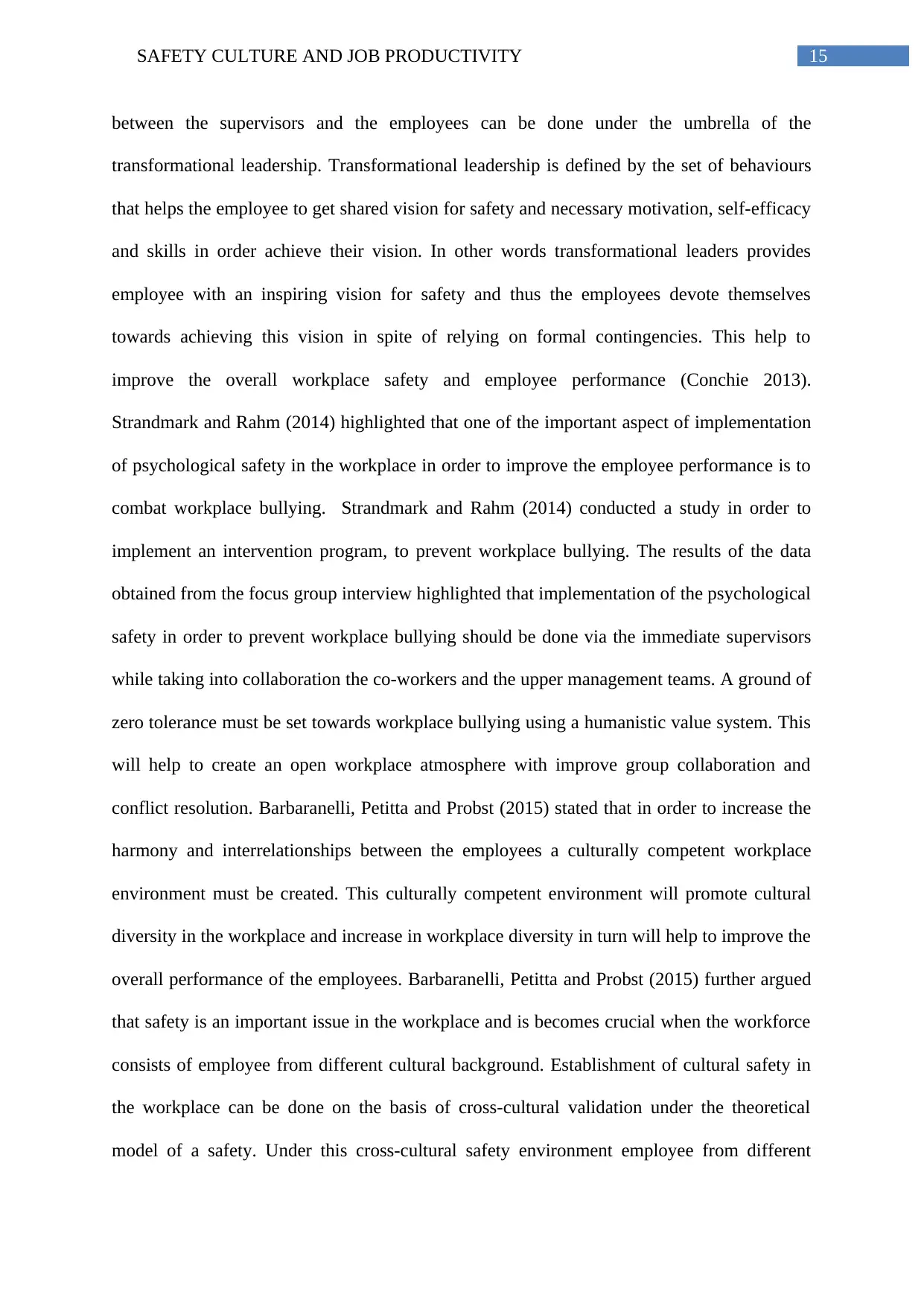
between the supervisors and the employees can be done under the umbrella of the
transformational leadership. Transformational leadership is defined by the set of behaviours
that helps the employee to get shared vision for safety and necessary motivation, self-efficacy
and skills in order achieve their vision. In other words transformational leaders provides
employee with an inspiring vision for safety and thus the employees devote themselves
towards achieving this vision in spite of relying on formal contingencies. This help to
improve the overall workplace safety and employee performance (Conchie 2013).
Strandmark and Rahm (2014) highlighted that one of the important aspect of implementation
of psychological safety in the workplace in order to improve the employee performance is to
combat workplace bullying. Strandmark and Rahm (2014) conducted a study in order to
implement an intervention program, to prevent workplace bullying. The results of the data
obtained from the focus group interview highlighted that implementation of the psychological
safety in order to prevent workplace bullying should be done via the immediate supervisors
while taking into collaboration the co-workers and the upper management teams. A ground of
zero tolerance must be set towards workplace bullying using a humanistic value system. This
will help to create an open workplace atmosphere with improve group collaboration and
conflict resolution. Barbaranelli, Petitta and Probst (2015) stated that in order to increase the
harmony and interrelationships between the employees a culturally competent workplace
environment must be created. This culturally competent environment will promote cultural
diversity in the workplace and increase in workplace diversity in turn will help to improve the
overall performance of the employees. Barbaranelli, Petitta and Probst (2015) further argued
that safety is an important issue in the workplace and is becomes crucial when the workforce
consists of employee from different cultural background. Establishment of cultural safety in
the workplace can be done on the basis of cross-cultural validation under the theoretical
model of a safety. Under this cross-cultural safety environment employee from different
Paraphrase This Document
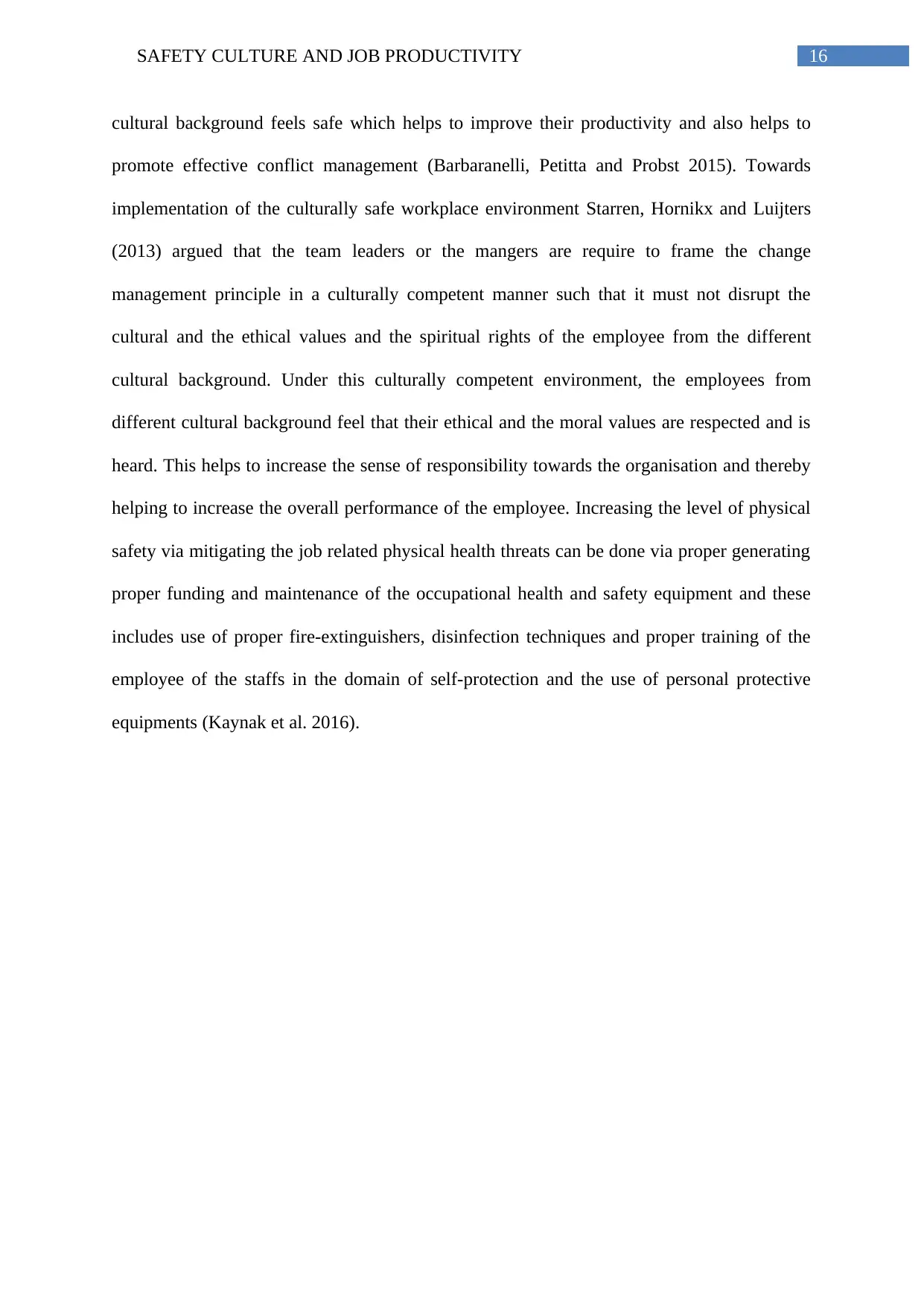
cultural background feels safe which helps to improve their productivity and also helps to
promote effective conflict management (Barbaranelli, Petitta and Probst 2015). Towards
implementation of the culturally safe workplace environment Starren, Hornikx and Luijters
(2013) argued that the team leaders or the mangers are require to frame the change
management principle in a culturally competent manner such that it must not disrupt the
cultural and the ethical values and the spiritual rights of the employee from the different
cultural background. Under this culturally competent environment, the employees from
different cultural background feel that their ethical and the moral values are respected and is
heard. This helps to increase the sense of responsibility towards the organisation and thereby
helping to increase the overall performance of the employee. Increasing the level of physical
safety via mitigating the job related physical health threats can be done via proper generating
proper funding and maintenance of the occupational health and safety equipment and these
includes use of proper fire-extinguishers, disinfection techniques and proper training of the
employee of the staffs in the domain of self-protection and the use of personal protective
equipments (Kaynak et al. 2016).
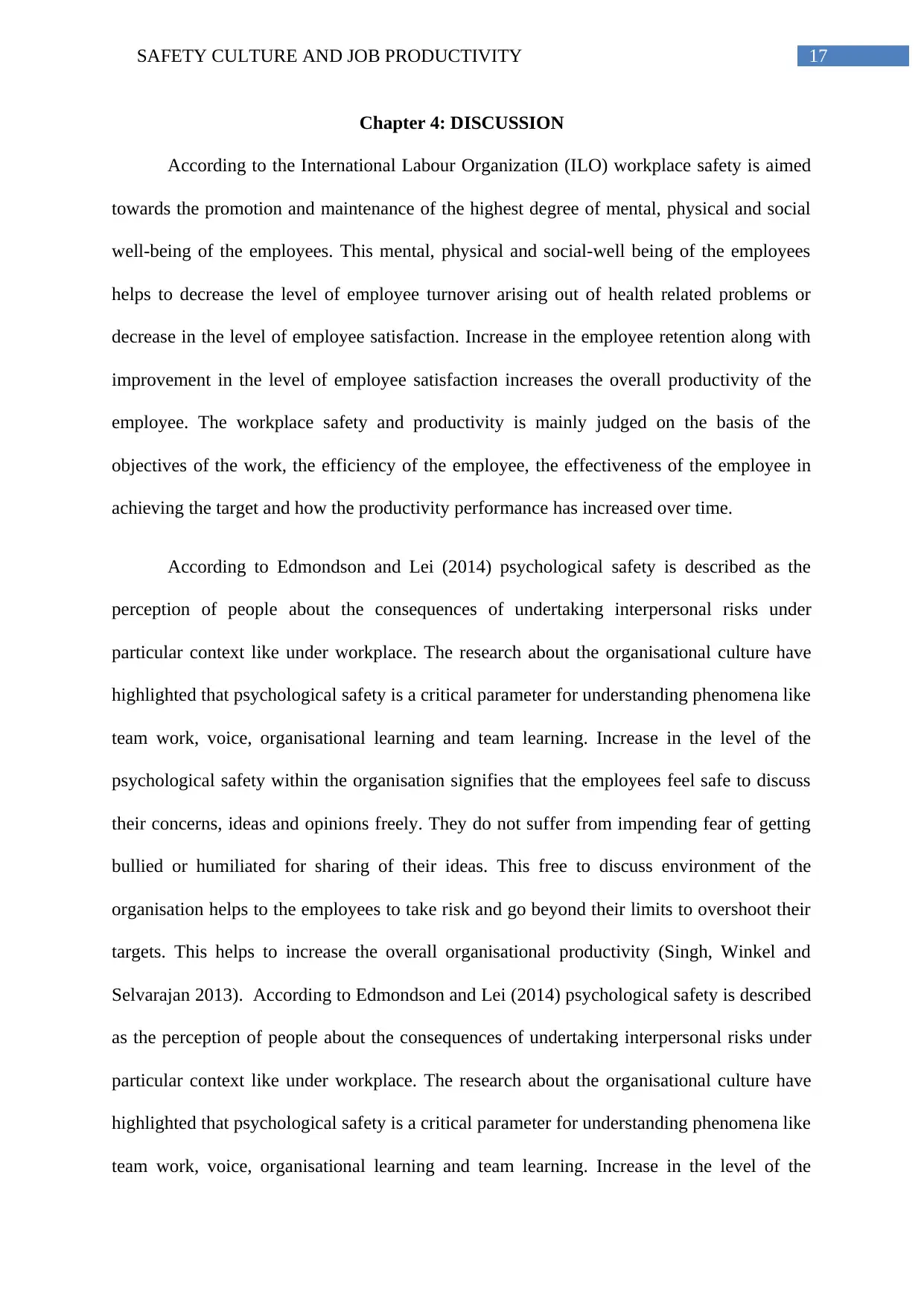
Chapter 4: DISCUSSION
According to the International Labour Organization (ILO) workplace safety is aimed
towards the promotion and maintenance of the highest degree of mental, physical and social
well-being of the employees. This mental, physical and social-well being of the employees
helps to decrease the level of employee turnover arising out of health related problems or
decrease in the level of employee satisfaction. Increase in the employee retention along with
improvement in the level of employee satisfaction increases the overall productivity of the
employee. The workplace safety and productivity is mainly judged on the basis of the
objectives of the work, the efficiency of the employee, the effectiveness of the employee in
achieving the target and how the productivity performance has increased over time.
According to Edmondson and Lei (2014) psychological safety is described as the
perception of people about the consequences of undertaking interpersonal risks under
particular context like under workplace. The research about the organisational culture have
highlighted that psychological safety is a critical parameter for understanding phenomena like
team work, voice, organisational learning and team learning. Increase in the level of the
psychological safety within the organisation signifies that the employees feel safe to discuss
their concerns, ideas and opinions freely. They do not suffer from impending fear of getting
bullied or humiliated for sharing of their ideas. This free to discuss environment of the
organisation helps to the employees to take risk and go beyond their limits to overshoot their
targets. This helps to increase the overall organisational productivity (Singh, Winkel and
Selvarajan 2013). According to Edmondson and Lei (2014) psychological safety is described
as the perception of people about the consequences of undertaking interpersonal risks under
particular context like under workplace. The research about the organisational culture have
highlighted that psychological safety is a critical parameter for understanding phenomena like
team work, voice, organisational learning and team learning. Increase in the level of the
⊘ This is a preview!⊘
Do you want full access?
Subscribe today to unlock all pages.

Trusted by 1+ million students worldwide
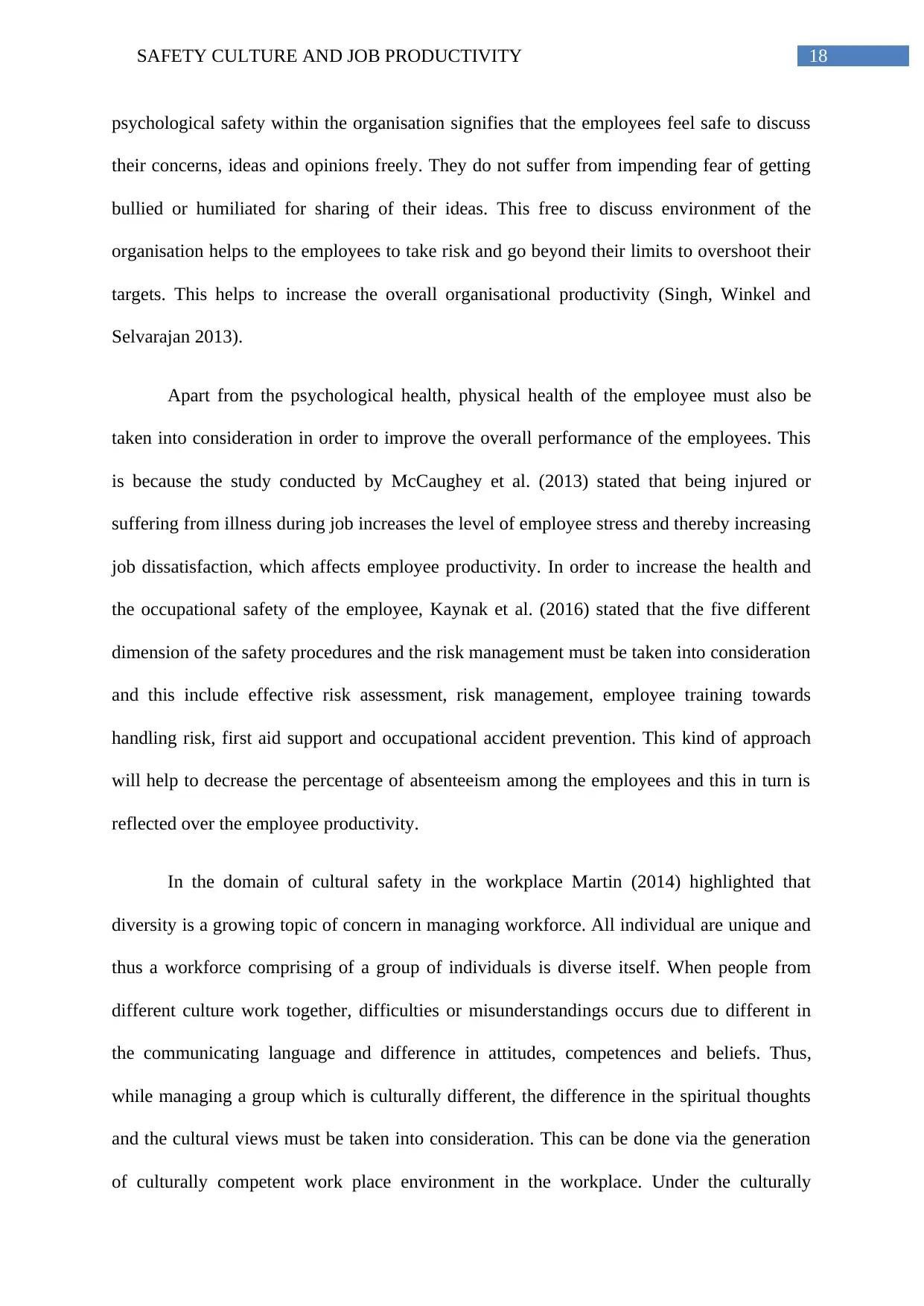
psychological safety within the organisation signifies that the employees feel safe to discuss
their concerns, ideas and opinions freely. They do not suffer from impending fear of getting
bullied or humiliated for sharing of their ideas. This free to discuss environment of the
organisation helps to the employees to take risk and go beyond their limits to overshoot their
targets. This helps to increase the overall organisational productivity (Singh, Winkel and
Selvarajan 2013).
Apart from the psychological health, physical health of the employee must also be
taken into consideration in order to improve the overall performance of the employees. This
is because the study conducted by McCaughey et al. (2013) stated that being injured or
suffering from illness during job increases the level of employee stress and thereby increasing
job dissatisfaction, which affects employee productivity. In order to increase the health and
the occupational safety of the employee, Kaynak et al. (2016) stated that the five different
dimension of the safety procedures and the risk management must be taken into consideration
and this include effective risk assessment, risk management, employee training towards
handling risk, first aid support and occupational accident prevention. This kind of approach
will help to decrease the percentage of absenteeism among the employees and this in turn is
reflected over the employee productivity.
In the domain of cultural safety in the workplace Martin (2014) highlighted that
diversity is a growing topic of concern in managing workforce. All individual are unique and
thus a workforce comprising of a group of individuals is diverse itself. When people from
different culture work together, difficulties or misunderstandings occurs due to different in
the communicating language and difference in attitudes, competences and beliefs. Thus,
while managing a group which is culturally different, the difference in the spiritual thoughts
and the cultural views must be taken into consideration. This can be done via the generation
of culturally competent work place environment in the workplace. Under the culturally
Paraphrase This Document
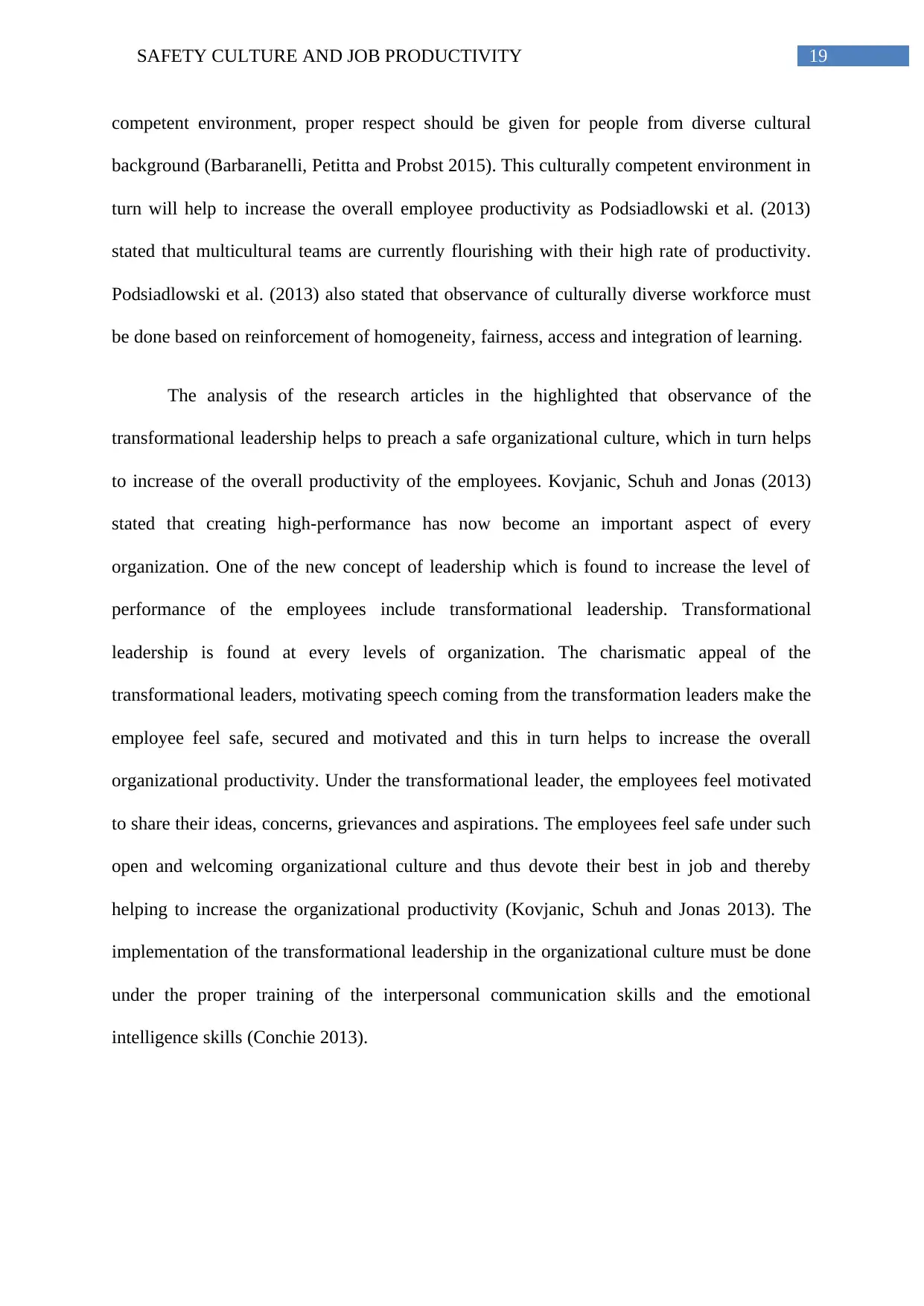
competent environment, proper respect should be given for people from diverse cultural
background (Barbaranelli, Petitta and Probst 2015). This culturally competent environment in
turn will help to increase the overall employee productivity as Podsiadlowski et al. (2013)
stated that multicultural teams are currently flourishing with their high rate of productivity.
Podsiadlowski et al. (2013) also stated that observance of culturally diverse workforce must
be done based on reinforcement of homogeneity, fairness, access and integration of learning.
The analysis of the research articles in the highlighted that observance of the
transformational leadership helps to preach a safe organizational culture, which in turn helps
to increase of the overall productivity of the employees. Kovjanic, Schuh and Jonas (2013)
stated that creating high-performance has now become an important aspect of every
organization. One of the new concept of leadership which is found to increase the level of
performance of the employees include transformational leadership. Transformational
leadership is found at every levels of organization. The charismatic appeal of the
transformational leaders, motivating speech coming from the transformation leaders make the
employee feel safe, secured and motivated and this in turn helps to increase the overall
organizational productivity. Under the transformational leader, the employees feel motivated
to share their ideas, concerns, grievances and aspirations. The employees feel safe under such
open and welcoming organizational culture and thus devote their best in job and thereby
helping to increase the organizational productivity (Kovjanic, Schuh and Jonas 2013). The
implementation of the transformational leadership in the organizational culture must be done
under the proper training of the interpersonal communication skills and the emotional
intelligence skills (Conchie 2013).
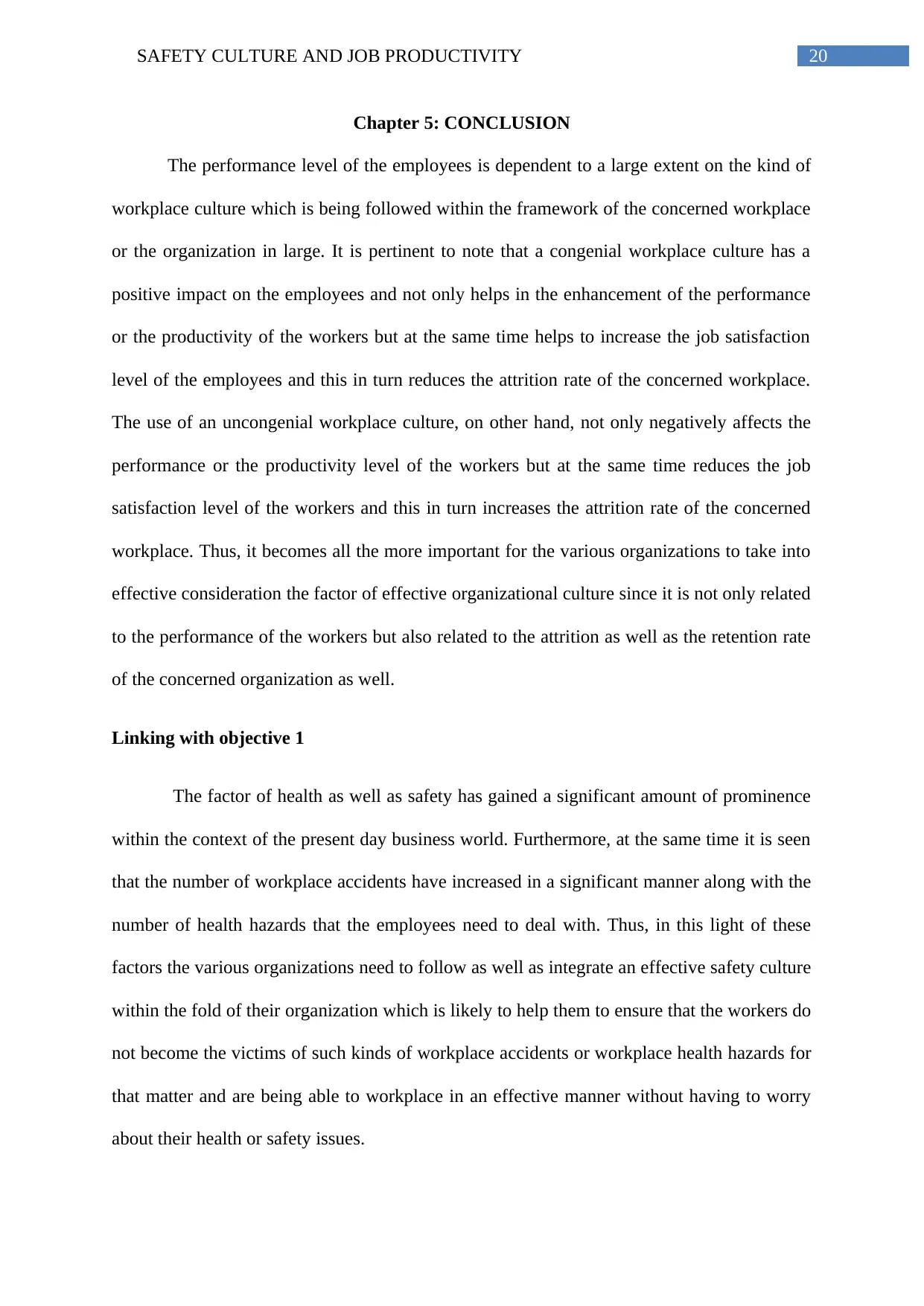
Chapter 5: CONCLUSION
The performance level of the employees is dependent to a large extent on the kind of
workplace culture which is being followed within the framework of the concerned workplace
or the organization in large. It is pertinent to note that a congenial workplace culture has a
positive impact on the employees and not only helps in the enhancement of the performance
or the productivity of the workers but at the same time helps to increase the job satisfaction
level of the employees and this in turn reduces the attrition rate of the concerned workplace.
The use of an uncongenial workplace culture, on other hand, not only negatively affects the
performance or the productivity level of the workers but at the same time reduces the job
satisfaction level of the workers and this in turn increases the attrition rate of the concerned
workplace. Thus, it becomes all the more important for the various organizations to take into
effective consideration the factor of effective organizational culture since it is not only related
to the performance of the workers but also related to the attrition as well as the retention rate
of the concerned organization as well.
Linking with objective 1
The factor of health as well as safety has gained a significant amount of prominence
within the context of the present day business world. Furthermore, at the same time it is seen
that the number of workplace accidents have increased in a significant manner along with the
number of health hazards that the employees need to deal with. Thus, in this light of these
factors the various organizations need to follow as well as integrate an effective safety culture
within the fold of their organization which is likely to help them to ensure that the workers do
not become the victims of such kinds of workplace accidents or workplace health hazards for
that matter and are being able to workplace in an effective manner without having to worry
about their health or safety issues.
⊘ This is a preview!⊘
Do you want full access?
Subscribe today to unlock all pages.

Trusted by 1+ million students worldwide
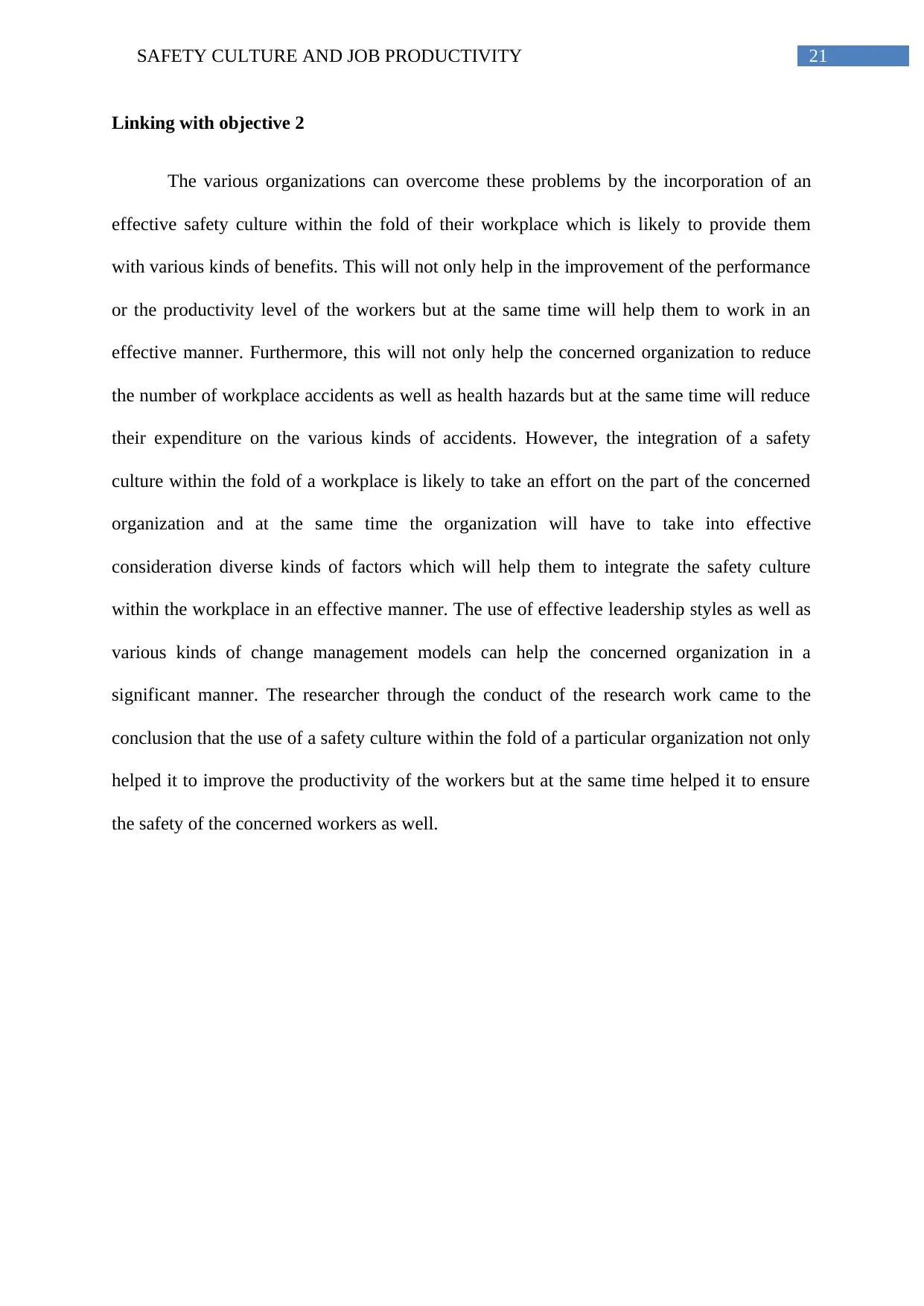
Linking with objective 2
The various organizations can overcome these problems by the incorporation of an
effective safety culture within the fold of their workplace which is likely to provide them
with various kinds of benefits. This will not only help in the improvement of the performance
or the productivity level of the workers but at the same time will help them to work in an
effective manner. Furthermore, this will not only help the concerned organization to reduce
the number of workplace accidents as well as health hazards but at the same time will reduce
their expenditure on the various kinds of accidents. However, the integration of a safety
culture within the fold of a workplace is likely to take an effort on the part of the concerned
organization and at the same time the organization will have to take into effective
consideration diverse kinds of factors which will help them to integrate the safety culture
within the workplace in an effective manner. The use of effective leadership styles as well as
various kinds of change management models can help the concerned organization in a
significant manner. The researcher through the conduct of the research work came to the
conclusion that the use of a safety culture within the fold of a particular organization not only
helped it to improve the productivity of the workers but at the same time helped it to ensure
the safety of the concerned workers as well.
Paraphrase This Document
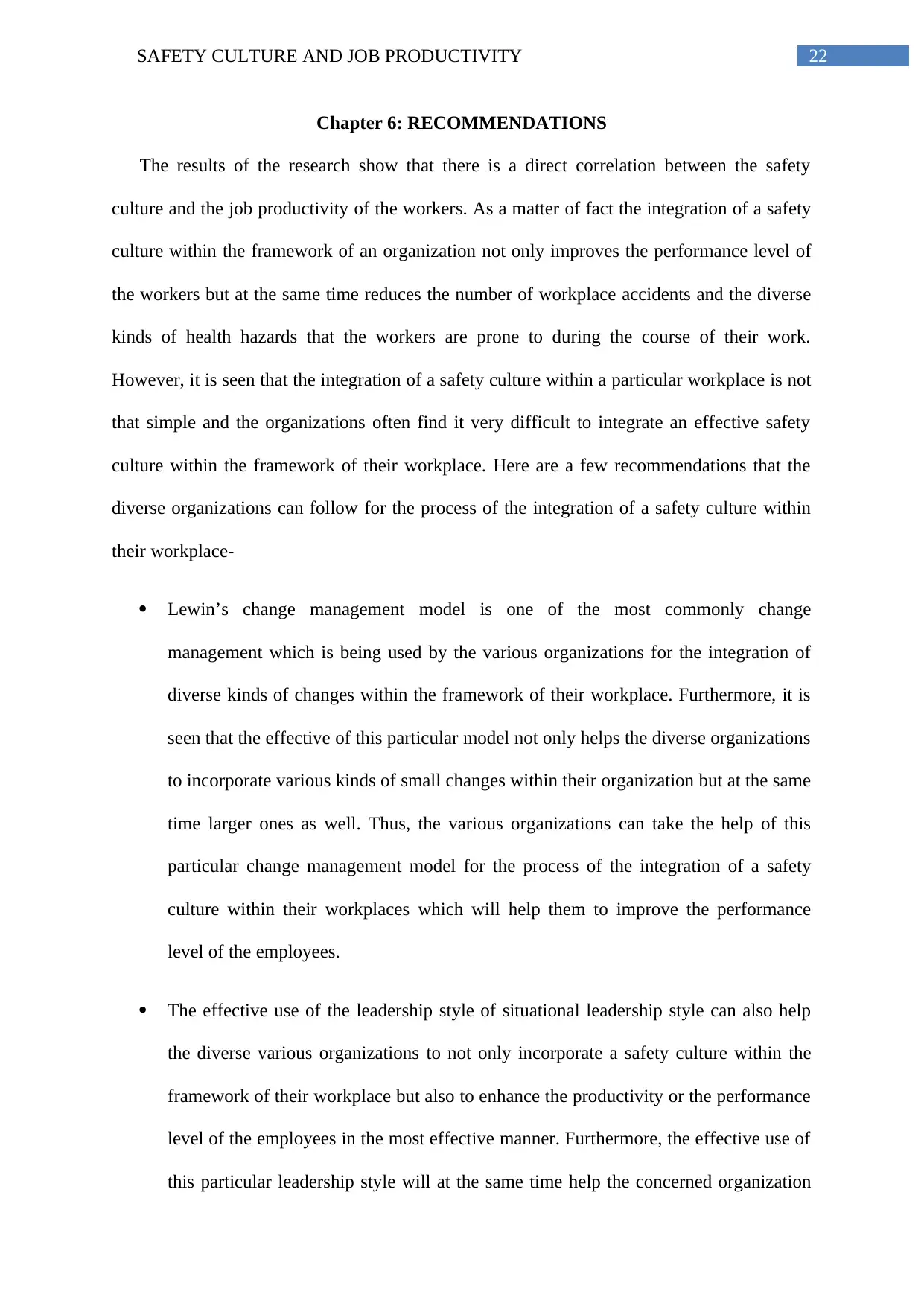
Chapter 6: RECOMMENDATIONS
The results of the research show that there is a direct correlation between the safety
culture and the job productivity of the workers. As a matter of fact the integration of a safety
culture within the framework of an organization not only improves the performance level of
the workers but at the same time reduces the number of workplace accidents and the diverse
kinds of health hazards that the workers are prone to during the course of their work.
However, it is seen that the integration of a safety culture within a particular workplace is not
that simple and the organizations often find it very difficult to integrate an effective safety
culture within the framework of their workplace. Here are a few recommendations that the
diverse organizations can follow for the process of the integration of a safety culture within
their workplace-
Lewin’s change management model is one of the most commonly change
management which is being used by the various organizations for the integration of
diverse kinds of changes within the framework of their workplace. Furthermore, it is
seen that the effective of this particular model not only helps the diverse organizations
to incorporate various kinds of small changes within their organization but at the same
time larger ones as well. Thus, the various organizations can take the help of this
particular change management model for the process of the integration of a safety
culture within their workplaces which will help them to improve the performance
level of the employees.
The effective use of the leadership style of situational leadership style can also help
the diverse various organizations to not only incorporate a safety culture within the
framework of their workplace but also to enhance the productivity or the performance
level of the employees in the most effective manner. Furthermore, the effective use of
this particular leadership style will at the same time help the concerned organization
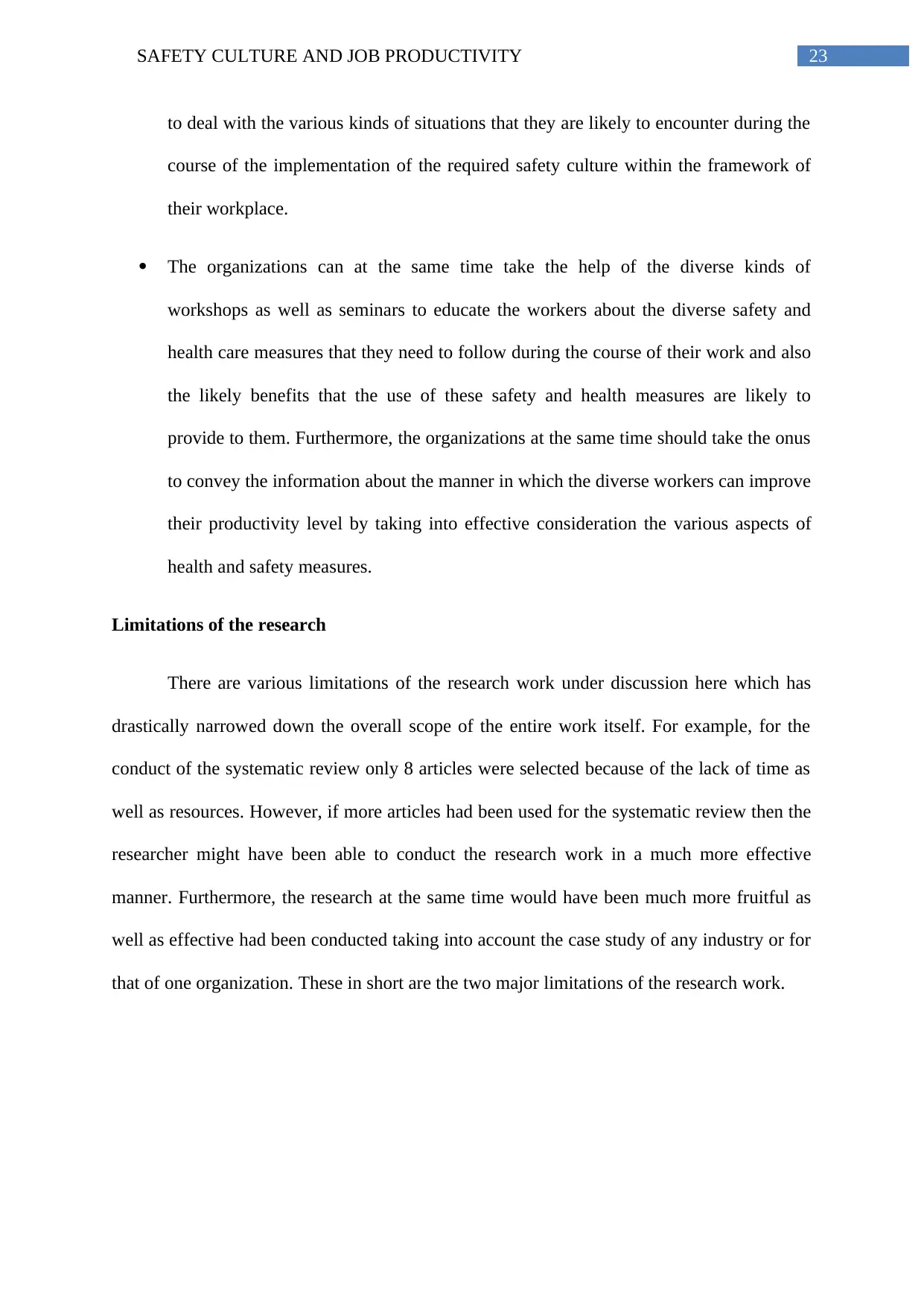
to deal with the various kinds of situations that they are likely to encounter during the
course of the implementation of the required safety culture within the framework of
their workplace.
The organizations can at the same time take the help of the diverse kinds of
workshops as well as seminars to educate the workers about the diverse safety and
health care measures that they need to follow during the course of their work and also
the likely benefits that the use of these safety and health measures are likely to
provide to them. Furthermore, the organizations at the same time should take the onus
to convey the information about the manner in which the diverse workers can improve
their productivity level by taking into effective consideration the various aspects of
health and safety measures.
Limitations of the research
There are various limitations of the research work under discussion here which has
drastically narrowed down the overall scope of the entire work itself. For example, for the
conduct of the systematic review only 8 articles were selected because of the lack of time as
well as resources. However, if more articles had been used for the systematic review then the
researcher might have been able to conduct the research work in a much more effective
manner. Furthermore, the research at the same time would have been much more fruitful as
well as effective had been conducted taking into account the case study of any industry or for
that of one organization. These in short are the two major limitations of the research work.
⊘ This is a preview!⊘
Do you want full access?
Subscribe today to unlock all pages.

Trusted by 1+ million students worldwide

References
Al-Refaie, A., 2013. Factors affect companies’ safety performance in Jordan using structural
equation modeling. Safety science, 57, pp.169-178.
Barbaranelli, C., Petitta, L. and Probst, T.M., 2015. Does safety climate predict safety
performance in Italy and the USA? Cross-cultural validation of a theoretical model of safety
climate. Accident Analysis & Prevention, 77, pp.35-44.
Beus, J.M., Dhanani, L.Y. and McCord, M.A., 2015. A meta-analysis of personality and
workplace safety: Addressing unanswered questions. Journal of applied psychology, 100(2),
p.481.
Choy, L.T., 2014. The strengths and weaknesses of research methodology: Comparison and
complimentary between qualitative and quantitative approaches. IOSR Journal of Humanities
and Social Science, 19(4), pp.99-104.
Conchie, S.M., 2013. Transformational leadership, intrinsic motivation, and trust: A
moderated-mediated model of workplace safety. Journal of occupational health
psychology, 18(2), p.198.
Cooper, D., 2015. Effective safety leadership: Understanding types & styles that improve
safety performance. Professional Safety, 60(02), pp.49-53.
Dang, G. and Pheng, L.S., 2015. Research methodology. In Infrastructure Investments in
Developing Economies (pp. 135-155). Springer, Singapore.
Edmondson, A.C. and Lei, Z., 2014. Psychological safety: The history, renaissance, and
future of an interpersonal construct. Annu. Rev. Organ. Psychol. Organ. Behav., 1(1), pp.23-
43.
Paraphrase This Document
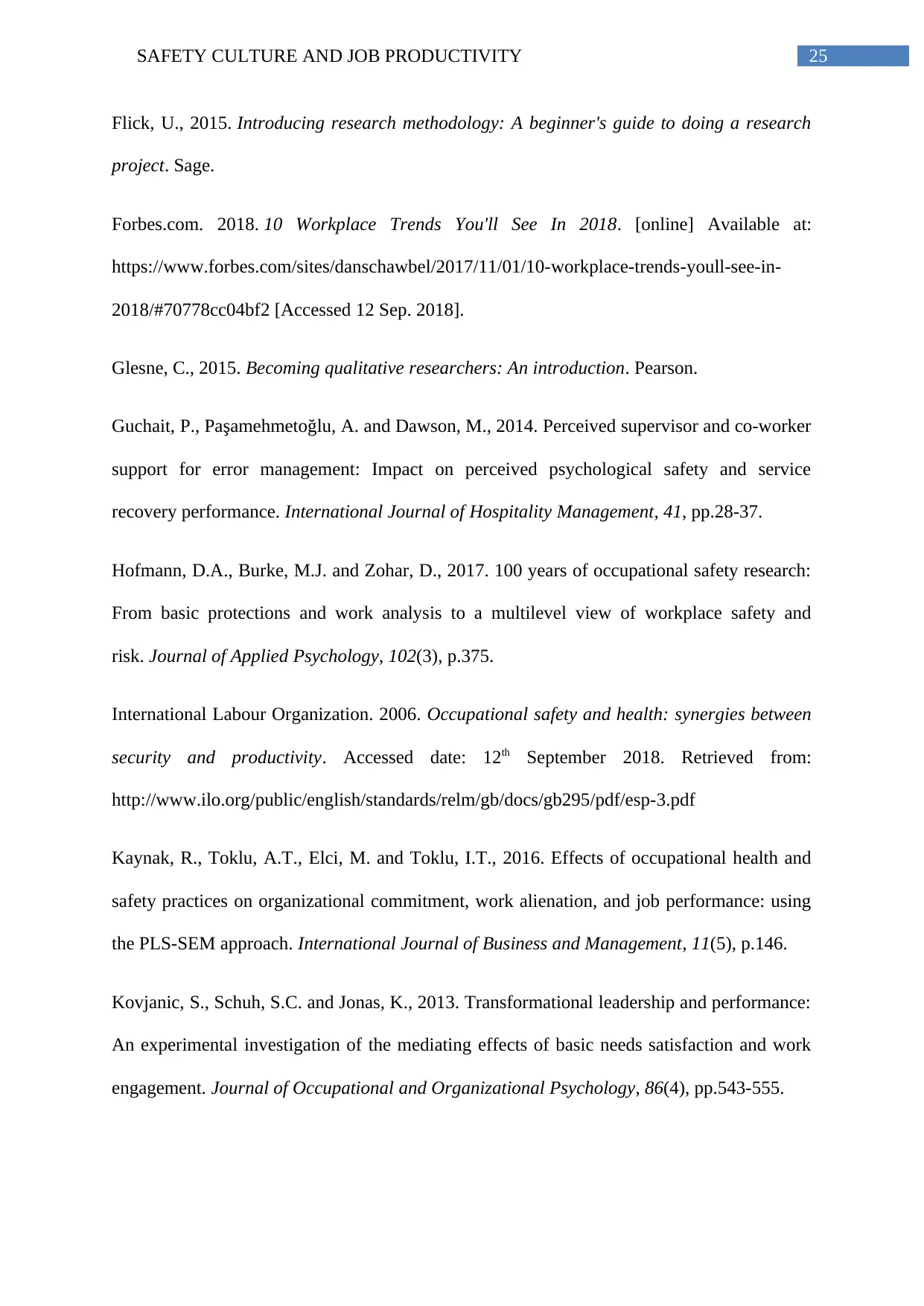
Flick, U., 2015. Introducing research methodology: A beginner's guide to doing a research
project. Sage.
Forbes.com. 2018. 10 Workplace Trends You'll See In 2018. [online] Available at:
https://www.forbes.com/sites/danschawbel/2017/11/01/10-workplace-trends-youll-see-in-
2018/#70778cc04bf2 [Accessed 12 Sep. 2018].
Glesne, C., 2015. Becoming qualitative researchers: An introduction. Pearson.
Guchait, P., Paşamehmetoğlu, A. and Dawson, M., 2014. Perceived supervisor and co-worker
support for error management: Impact on perceived psychological safety and service
recovery performance. International Journal of Hospitality Management, 41, pp.28-37.
Hofmann, D.A., Burke, M.J. and Zohar, D., 2017. 100 years of occupational safety research:
From basic protections and work analysis to a multilevel view of workplace safety and
risk. Journal of Applied Psychology, 102(3), p.375.
International Labour Organization. 2006. Occupational safety and health: synergies between
security and productivity. Accessed date: 12th September 2018. Retrieved from:
http://www.ilo.org/public/english/standards/relm/gb/docs/gb295/pdf/esp-3.pdf
Kaynak, R., Toklu, A.T., Elci, M. and Toklu, I.T., 2016. Effects of occupational health and
safety practices on organizational commitment, work alienation, and job performance: using
the PLS-SEM approach. International Journal of Business and Management, 11(5), p.146.
Kovjanic, S., Schuh, S.C. and Jonas, K., 2013. Transformational leadership and performance:
An experimental investigation of the mediating effects of basic needs satisfaction and work
engagement. Journal of Occupational and Organizational Psychology, 86(4), pp.543-555.
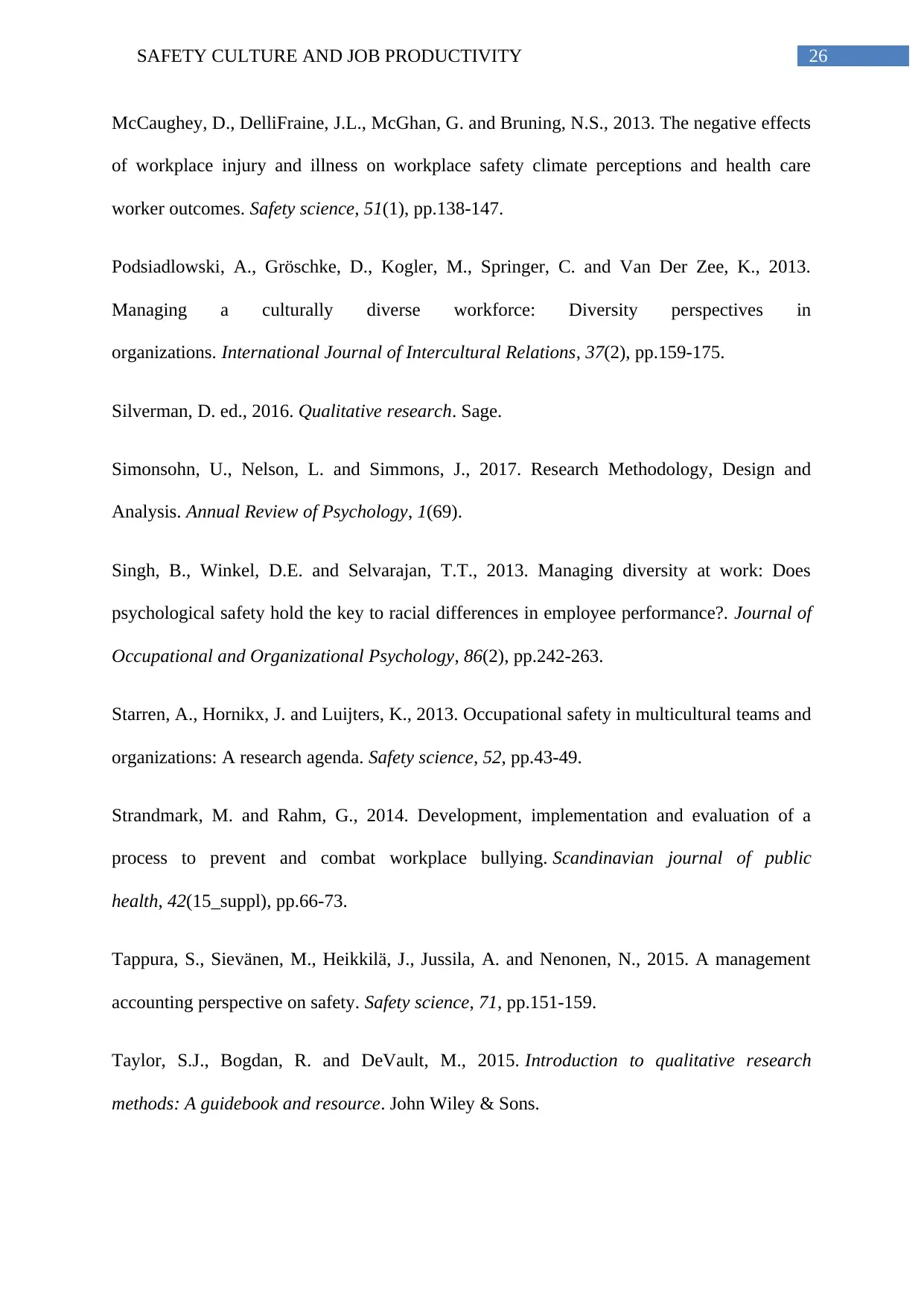
McCaughey, D., DelliFraine, J.L., McGhan, G. and Bruning, N.S., 2013. The negative effects
of workplace injury and illness on workplace safety climate perceptions and health care
worker outcomes. Safety science, 51(1), pp.138-147.
Podsiadlowski, A., Gröschke, D., Kogler, M., Springer, C. and Van Der Zee, K., 2013.
Managing a culturally diverse workforce: Diversity perspectives in
organizations. International Journal of Intercultural Relations, 37(2), pp.159-175.
Silverman, D. ed., 2016. Qualitative research. Sage.
Simonsohn, U., Nelson, L. and Simmons, J., 2017. Research Methodology, Design and
Analysis. Annual Review of Psychology, 1(69).
Singh, B., Winkel, D.E. and Selvarajan, T.T., 2013. Managing diversity at work: Does
psychological safety hold the key to racial differences in employee performance?. Journal of
Occupational and Organizational Psychology, 86(2), pp.242-263.
Starren, A., Hornikx, J. and Luijters, K., 2013. Occupational safety in multicultural teams and
organizations: A research agenda. Safety science, 52, pp.43-49.
Strandmark, M. and Rahm, G., 2014. Development, implementation and evaluation of a
process to prevent and combat workplace bullying. Scandinavian journal of public
health, 42(15_suppl), pp.66-73.
Tappura, S., Sievänen, M., Heikkilä, J., Jussila, A. and Nenonen, N., 2015. A management
accounting perspective on safety. Safety science, 71, pp.151-159.
Taylor, S.J., Bogdan, R. and DeVault, M., 2015. Introduction to qualitative research
methods: A guidebook and resource. John Wiley & Sons.
⊘ This is a preview!⊘
Do you want full access?
Subscribe today to unlock all pages.

Trusted by 1+ million students worldwide
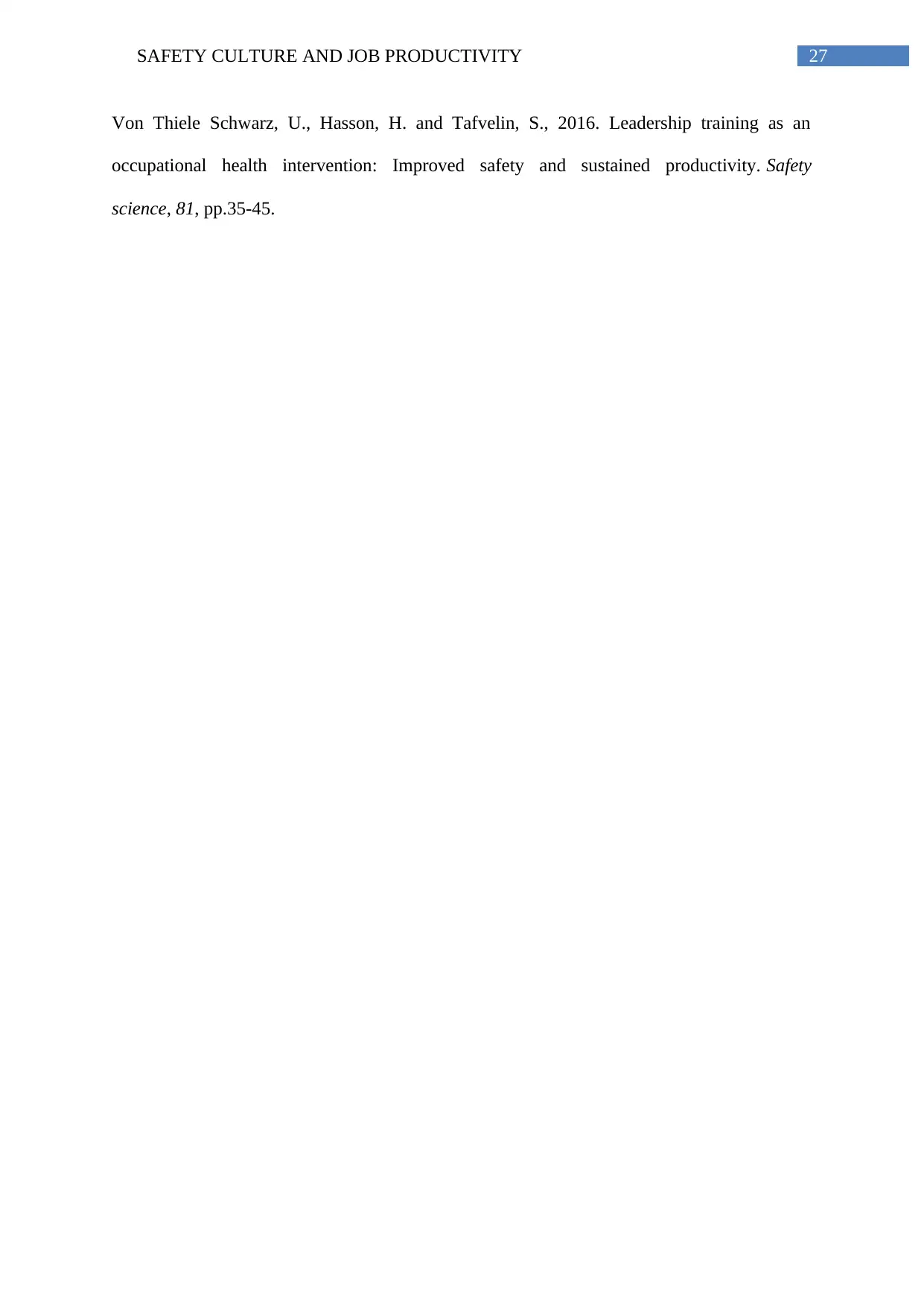
Von Thiele Schwarz, U., Hasson, H. and Tafvelin, S., 2016. Leadership training as an
occupational health intervention: Improved safety and sustained productivity. Safety
science, 81, pp.35-45.
Related Documents
Your All-in-One AI-Powered Toolkit for Academic Success.
+13062052269
info@desklib.com
Available 24*7 on WhatsApp / Email
![[object Object]](/_next/static/media/star-bottom.7253800d.svg)
© 2024 | Zucol Services PVT LTD | All rights reserved.




